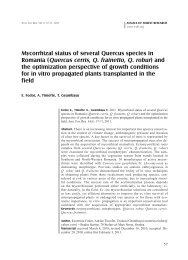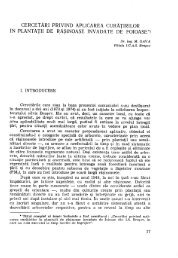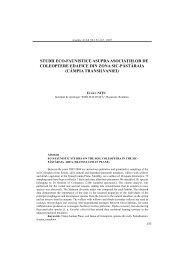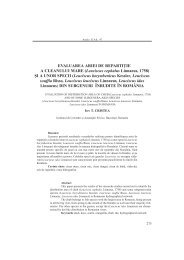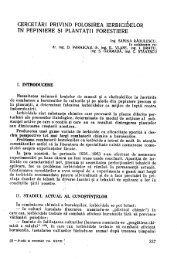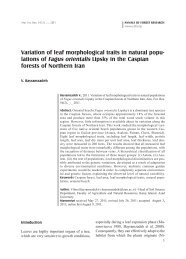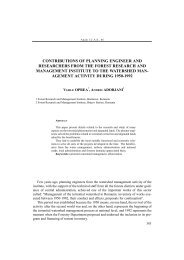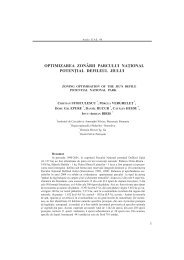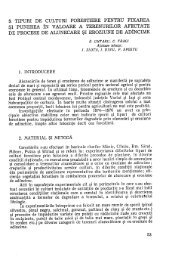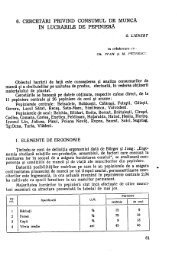Survival and growth responses of Jatropha curcas ... - EdituraSilvica.ro
Survival and growth responses of Jatropha curcas ... - EdituraSilvica.ro
Survival and growth responses of Jatropha curcas ... - EdituraSilvica.ro
You also want an ePaper? Increase the reach of your titles
YUMPU automatically turns print PDFs into web optimized ePapers that Google loves.
Ann. For. Res. 54(2): 171-184, 2011<br />
ANNALS OF FOREST RESEARCH<br />
www.e-afr.org<br />
<st<strong>ro</strong>ng>Survival</st<strong>ro</strong>ng> <st<strong>ro</strong>ng>and</st<strong>ro</strong>ng> <st<strong>ro</strong>ng>g<strong>ro</strong>wth</st<strong>ro</strong>ng> <st<strong>ro</strong>ng>responses</st<strong>ro</strong>ng> <st<strong>ro</strong>ng>of</st<strong>ro</strong>ng> <st<strong>ro</strong>ng>Jat<strong>ro</strong>pha</st<strong>ro</strong>ng> <st<strong>ro</strong>ng>curcas</st<strong>ro</strong>ng> L.<br />
to three restoration techniques on degraded soils<br />
in Burkina Faso<br />
W. F. Kagamèbga, A. Thiombiano, S. Traoré, R. Zougmoré, J. I. Boussim<br />
Kagamèbga W. F., Thiombiano A., Traoré S., Zougmoré R., Boussim J. I., 2011.<br />
<st<strong>ro</strong>ng>Survival</st<strong>ro</strong>ng> <st<strong>ro</strong>ng>and</st<strong>ro</strong>ng> <st<strong>ro</strong>ng>g<strong>ro</strong>wth</st<strong>ro</strong>ng> <st<strong>ro</strong>ng>responses</st<strong>ro</strong>ng> <st<strong>ro</strong>ng>of</st<strong>ro</strong>ng> <st<strong>ro</strong>ng>Jat<strong>ro</strong>pha</st<strong>ro</strong>ng> <st<strong>ro</strong>ng>curcas</st<strong>ro</strong>ng> L. to three restoration techniques<br />
on degraded soils in Burkina Faso. Ann. For. Res. 54(2): 171-184, 2011.<br />
Abstract. L<st<strong>ro</strong>ng>and</st<strong>ro</strong>ng> degradation is a major p<strong>ro</strong>blem in the Sahelian countries. E<strong>ro</strong>sion<br />
cont<strong>ro</strong>l th<strong>ro</strong>ugh establishment <st<strong>ro</strong>ng>of</st<strong>ro</strong>ng> vegetation cover is at important strategy to reverse<br />
the trend. Our research objective was to analyse the effects <st<strong>ro</strong>ng>of</st<strong>ro</strong>ng> three restoration techniques<br />
on <st<strong>ro</strong>ng>Jat<strong>ro</strong>pha</st<strong>ro</strong>ng> <st<strong>ro</strong>ng>curcas</st<strong>ro</strong>ng> L. seedlings <st<strong>ro</strong>ng>g<strong>ro</strong>wth</st<strong>ro</strong>ng> <st<strong>ro</strong>ng>and</st<strong>ro</strong>ng> survivorship. We are conducted<br />
two separate field trials, involving the sowing <st<strong>ro</strong>ng>and</st<strong>ro</strong>ng> planting <st<strong>ro</strong>ng>of</st<strong>ro</strong>ng> J. <st<strong>ro</strong>ng>curcas</st<strong>ro</strong>ng>, in which<br />
several different soil restoration techniques were applied. The trial was monitored<br />
using a r<st<strong>ro</strong>ng>and</st<strong>ro</strong>ng>omized block study design over a period <st<strong>ro</strong>ng>of</st<strong>ro</strong>ng> two years. The design<br />
included ten different treatments, six in the sowing trial <st<strong>ro</strong>ng>and</st<strong>ro</strong>ng> four in the planting<br />
trial, each with three replicates. In the first experiment, <st<strong>ro</strong>ng>g<strong>ro</strong>wth</st<strong>ro</strong>ng> rate was found to be<br />
significantly higher in the Sub-Soiling treatment, that received additional organic<br />
matter than other treatments. However, overall survival rate was low (18%). In the<br />
second experiment, the Half-moon treatment yielded a significantly higher <st<strong>ro</strong>ng>g<strong>ro</strong>wth</st<strong>ro</strong>ng><br />
both in height (df = 3, F = 56.74, p < 0.05) <st<strong>ro</strong>ng>and</st<strong>ro</strong>ng> diameter (df = 3, F = 31.76, p <<br />
0.05) <st<strong>ro</strong>ng>and</st<strong>ro</strong>ng> survival rate compared to those <st<strong>ro</strong>ng>of</st<strong>ro</strong>ng> the other treatments (df = 3, F = 50.4,<br />
p < 0.05). In conclusion, planting seedlings p<strong>ro</strong>duced a greater survival rate than<br />
sowing seeds. Among the soil restoration <st<strong>ro</strong>ng>and</st<strong>ro</strong>ng> water conservation techniques tested<br />
in this study, the Half-moon technique was found to be the most effective. This is<br />
recommended to be used for imp<strong>ro</strong>ving the revegetation <st<strong>ro</strong>ng>of</st<strong>ro</strong>ng> J. <st<strong>ro</strong>ng>curcas</st<strong>ro</strong>ng> in the future.<br />
Keywords soil degradation, l<st<strong>ro</strong>ng>and</st<strong>ro</strong>ng> reclamation, water harvesting, water infiltration,<br />
afforestation.<br />
Authors. François Wenemi Kagambèga, Adjima Thiombiano, Salifou Traoré,<br />
Joseph Issaka Boussim (wenemifrancois@yahoo.fr) - Université de Ouagadougou,<br />
Unité de Formation et de Recherche en Sciences de la vie et de la Terre, Laboratoire<br />
de Biologie et Ecologie Végétales, 09 BP 848 Ouagadougou 09, Burkina Faso.<br />
Robert Zougmoré - ICRISAT Sahelian Center, BP 12404, Niamey, Niger.<br />
Manuscript received March 28, 2011; revised June 29, 2011; accepted July 4, 2011;<br />
online first July 5, 2011.<br />
171
Ann. For. Res. 54(2): 171-184, 2011<br />
Int<strong>ro</strong>duction<br />
L<st<strong>ro</strong>ng>and</st<strong>ro</strong>ng> degradation, defined as the loss <st<strong>ro</strong>ng>of</st<strong>ro</strong>ng> p<strong>ro</strong>duction<br />
capacity in terms <st<strong>ro</strong>ng>of</st<strong>ro</strong>ng> loss <st<strong>ro</strong>ng>of</st<strong>ro</strong>ng> soil fertility,<br />
soil biodiversity <st<strong>ro</strong>ng>and</st<strong>ro</strong>ng> degradation <st<strong>ro</strong>ng>of</st<strong>ro</strong>ng> natural<br />
resources (Lal 2004), remains one <st<strong>ro</strong>ng>of</st<strong>ro</strong>ng> the<br />
most serious envi<strong>ro</strong>nmental p<strong>ro</strong>blems, which<br />
continues to threaten the livelihoods <st<strong>ro</strong>ng>of</st<strong>ro</strong>ng> many<br />
people worldwide. It is the result <st<strong>ro</strong>ng>of</st<strong>ro</strong>ng> many factors,<br />
such as dryness, loss <st<strong>ro</strong>ng>of</st<strong>ro</strong>ng> vegetation, soil<br />
e<strong>ro</strong>sion, inapp<strong>ro</strong>priate l<st<strong>ro</strong>ng>and</st<strong>ro</strong>ng> use <st<strong>ro</strong>ng>and</st<strong>ro</strong>ng> poor management.<br />
An estimated US 42 billion in income<br />
<st<strong>ro</strong>ng>and</st<strong>ro</strong>ng> 6 million ha <st<strong>ro</strong>ng>of</st<strong>ro</strong>ng> p<strong>ro</strong>ductive l<st<strong>ro</strong>ng>and</st<strong>ro</strong>ng> are<br />
lost every year due to l<st<strong>ro</strong>ng>and</st<strong>ro</strong>ng> degradation <st<strong>ro</strong>ng>and</st<strong>ro</strong>ng> declining<br />
agricultural p<strong>ro</strong>ductivity (UNDP-GEF<br />
2004). More than half <st<strong>ro</strong>ng>of</st<strong>ro</strong>ng> all African people are<br />
affected by l<st<strong>ro</strong>ng>and</st<strong>ro</strong>ng> degradation, making it one <st<strong>ro</strong>ng>of</st<strong>ro</strong>ng><br />
the continent’s urgent development issues with<br />
significant cost – Africa is burdened with a US<br />
$ 9.3 billion annual cost <st<strong>ro</strong>ng>of</st<strong>ro</strong>ng> desertification (Bationo<br />
et al. 2007).<br />
Like other Sahelian countries, Burkina Faso<br />
is facing significant <st<strong>ro</strong>ng>and</st<strong>ro</strong>ng> continuous degradation<br />
<st<strong>ro</strong>ng>of</st<strong>ro</strong>ng> its natural resources (Zombre 2006).<br />
The combined effect <st<strong>ro</strong>ng>of</st<strong>ro</strong>ng> low soil fertility, mismanagement<br />
<st<strong>ro</strong>ng>of</st<strong>ro</strong>ng> ecosystems <st<strong>ro</strong>ng>and</st<strong>ro</strong>ng> extreme climatic<br />
conditions has resulted in zipellés: bare<br />
soils that have become sealed <st<strong>ro</strong>ng>and</st<strong>ro</strong>ng> encrusted<br />
(M<st<strong>ro</strong>ng>and</st<strong>ro</strong>ng>o et al. 2001). This phenomenon reduces<br />
the agricultural potential <st<strong>ro</strong>ng>of</st<strong>ro</strong>ng> the l<st<strong>ro</strong>ng>and</st<strong>ro</strong>ng>, resulting<br />
in poverty <st<strong>ro</strong>ng>and</st<strong>ro</strong>ng> immigration. Nearly<br />
24% <st<strong>ro</strong>ng>of</st<strong>ro</strong>ng> the soils <st<strong>ro</strong>ng>of</st<strong>ro</strong>ng> Burkina Faso have been<br />
reduced to zipellés, most notably in the central<br />
<st<strong>ro</strong>ng>and</st<strong>ro</strong>ng> northern regions (Zougmoré et al. 2004).<br />
This has major economic consequences for the<br />
country, as agricultural <st<strong>ro</strong>ng>and</st<strong>ro</strong>ng> pastoral activities<br />
are practiced by 90% <st<strong>ro</strong>ng>of</st<strong>ro</strong>ng> the population. Consequently,<br />
l<st<strong>ro</strong>ng>and</st<strong>ro</strong>ng> rehabilitation is essential to reverse<br />
the trend <st<strong>ro</strong>ng>of</st<strong>ro</strong>ng> degradation <st<strong>ro</strong>ng>and</st<strong>ro</strong>ng> to imp<strong>ro</strong>ve<br />
the p<strong>ro</strong>ductivity <st<strong>ro</strong>ng>of</st<strong>ro</strong>ng> soils.<br />
E<strong>ro</strong>sion cont<strong>ro</strong>l th<strong>ro</strong>ugh establishment <st<strong>ro</strong>ng>of</st<strong>ro</strong>ng><br />
vegetation cover <st<strong>ro</strong>ng>and</st<strong>ro</strong>ng> afforestation, soil fertility<br />
management though application <st<strong>ro</strong>ng>of</st<strong>ro</strong>ng> biosolids<br />
are important strategies (Lal 2004). Long term<br />
remediation efforts can achieve this using species<br />
that are able to withst<st<strong>ro</strong>ng>and</st<strong>ro</strong>ng> water-stress for<br />
Research article<br />
revegetation in degraded l<st<strong>ro</strong>ng>and</st<strong>ro</strong>ng>scapes (Lan et al.<br />
1997). For any rehabilitation p<strong>ro</strong>gramme to be<br />
successful, it must involve income-generation,<br />
with the aim <st<strong>ro</strong>ng>of</st<strong>ro</strong>ng> poverty alleviation (Ogunwole<br />
et al. 2008, Bognounou et al. 2010). <st<strong>ro</strong>ng>Jat<strong>ro</strong>pha</st<strong>ro</strong>ng><br />
<st<strong>ro</strong>ng>curcas</st<strong>ro</strong>ng> L. (JCL hereafter) is a d<strong>ro</strong>ught-resistant<br />
oil-p<strong>ro</strong>ducing plant, occurring th<strong>ro</strong>ughout<br />
t<strong>ro</strong>pical <st<strong>ro</strong>ng>and</st<strong>ro</strong>ng> subt<strong>ro</strong>pical areas, ac<strong>ro</strong>ss Central<br />
<st<strong>ro</strong>ng>and</st<strong>ro</strong>ng> South America, Africa, India <st<strong>ro</strong>ng>and</st<strong>ro</strong>ng> Southeast<br />
Asia (Schmook et al. 1997). It is used<br />
in poverty alleviation <st<strong>ro</strong>ng>and</st<strong>ro</strong>ng> income generation<br />
initiatives in rural areas <st<strong>ro</strong>ng>of</st<strong>ro</strong>ng> many developing<br />
countries. In the Sahel, in West Africa, JCL<br />
may be able to combat three <st<strong>ro</strong>ng>of</st<strong>ro</strong>ng> the largest challenges<br />
<st<strong>ro</strong>ng>of</st<strong>ro</strong>ng> the countries: energy supply, poverty<br />
<st<strong>ro</strong>ng>and</st<strong>ro</strong>ng> greenhouse gas emissions reduction. This<br />
enterprise has become extremely pr<st<strong>ro</strong>ng>of</st<strong>ro</strong>ng>itable for<br />
farmers <st<strong>ro</strong>ng>and</st<strong>ro</strong>ng> businessmens using the shrubs.<br />
Other benefits include the restoration <st<strong>ro</strong>ng>of</st<strong>ro</strong>ng> ecosystems<br />
<st<strong>ro</strong>ng>and</st<strong>ro</strong>ng> poverty alleviation in rural areas<br />
in Africa (Li Kun et al. 2007). JCL may be especially<br />
beneficial to the restoration <st<strong>ro</strong>ng>of</st<strong>ro</strong>ng> degraded<br />
ecosystems, as it is able to g<strong>ro</strong>w wild <st<strong>ro</strong>ng>and</st<strong>ro</strong>ng><br />
would not need to compete with conventional<br />
agricultural c<strong>ro</strong>ps (Juwarkar et al. 2008). Thus,<br />
JCL could potentially be a useful plant for the<br />
afforestation <st<strong>ro</strong>ng>of</st<strong>ro</strong>ng> the zipellés.<br />
Despite the heat <st<strong>ro</strong>ng>and</st<strong>ro</strong>ng> d<strong>ro</strong>ught tolerance <st<strong>ro</strong>ng>of</st<strong>ro</strong>ng><br />
JCL, it has been shown to have a low survival<br />
<st<strong>ro</strong>ng>and</st<strong>ro</strong>ng> rep<strong>ro</strong>ductive rate in barren areas (Li Kun et<br />
al. 2007). Thus, optimizing the establishment<br />
<st<strong>ro</strong>ng>of</st<strong>ro</strong>ng> JCL on degraded soils may require investigation<br />
into the imp<strong>ro</strong>vement <st<strong>ro</strong>ng>of</st<strong>ro</strong>ng> its <st<strong>ro</strong>ng>g<strong>ro</strong>wth</st<strong>ro</strong>ng> conditions.<br />
The range <st<strong>ro</strong>ng>of</st<strong>ro</strong>ng> species that can be used<br />
in this envi<strong>ro</strong>nment is limited, due to water<br />
scarcity (Bargali Tewari 2004). Therefore,<br />
the identification <st<strong>ro</strong>ng>of</st<strong>ro</strong>ng> a species able to withst<st<strong>ro</strong>ng>and</st<strong>ro</strong>ng><br />
these conditions will be the most important factor<br />
to consider (Kumar et al. 2008). The most<br />
effective way to increase soil p<strong>ro</strong>ductivity<br />
in the Sub-Saharan Zone is to ensure effective<br />
water infiltration <st<strong>ro</strong>ng>and</st<strong>ro</strong>ng> storage in the soil<br />
(Lal 1997). Water is not necessarily in short<br />
supply in the region; rather, the loss <st<strong>ro</strong>ng>of</st<strong>ro</strong>ng> water<br />
th<strong>ro</strong>ugh run<st<strong>ro</strong>ng>of</st<strong>ro</strong>ng>f, soil evaporation <st<strong>ro</strong>ng>and</st<strong>ro</strong>ng> drainage<br />
below the <strong>ro</strong>ot zone is highlighted as the cause<br />
172
Kagambèga et al. <st<strong>ro</strong>ng>Survival</st<strong>ro</strong>ng> <st<strong>ro</strong>ng>and</st<strong>ro</strong>ng> <st<strong>ro</strong>ng>g<strong>ro</strong>wth</st<strong>ro</strong>ng> <st<strong>ro</strong>ng>responses</st<strong>ro</strong>ng> <st<strong>ro</strong>ng>of</st<strong>ro</strong>ng> <st<strong>ro</strong>ng>Jat<strong>ro</strong>pha</st<strong>ro</strong>ng> <st<strong>ro</strong>ng>curcas</st<strong>ro</strong>ng> L. ...<br />
<st<strong>ro</strong>ng>of</st<strong>ro</strong>ng> water scarcity (Zougmoré et al. 2004). Various<br />
studies have demonstrated increases in soil<br />
water, as a result <st<strong>ro</strong>ng>of</st<strong>ro</strong>ng> some soil restoration methods<br />
such as half-moon, sub-soiling fur<strong>ro</strong>ws in<br />
soil <st<strong>ro</strong>ng>and</st<strong>ro</strong>ng> zaï technique (Zougmoré et al. 2003,<br />
Ganaba 2005). These techniques are particularly<br />
effective in reducing run<st<strong>ro</strong>ng>of</st<strong>ro</strong>ng>f <st<strong>ro</strong>ng>and</st<strong>ro</strong>ng> imp<strong>ro</strong>ving<br />
infiltration. Most research to date has had<br />
an agricultural focus. Comparatively, few studies<br />
have been conducted in the forestry sector<br />
(Ganaba et al. 2006). One element absent f<strong>ro</strong>m<br />
the above studies was an explicit consideration<br />
<st<strong>ro</strong>ng>of</st<strong>ro</strong>ng> these methods which may shape seedling<br />
<st<strong>ro</strong>ng>responses</st<strong>ro</strong>ng> to guarantee revegetation success<br />
th<strong>ro</strong>ugh their capacities to store water or nutrients,<br />
or to supply them to plants. How are<br />
the early survival <st<strong>ro</strong>ng>and</st<strong>ro</strong>ng> <st<strong>ro</strong>ng>g<strong>ro</strong>wth</st<strong>ro</strong>ng> <st<strong>ro</strong>ng>of</st<strong>ro</strong>ng> JCL seedlings<br />
affected by these techniques What are the implications<br />
<st<strong>ro</strong>ng>of</st<strong>ro</strong>ng> these <st<strong>ro</strong>ng>responses</st<strong>ro</strong>ng> for degraded l<st<strong>ro</strong>ng>and</st<strong>ro</strong>ng><br />
restoration efforts<br />
The research objective was to analyse the<br />
effects <st<strong>ro</strong>ng>of</st<strong>ro</strong>ng> different restoration techniques<br />
th<strong>ro</strong>ugh water levels <st<strong>ro</strong>ng>and</st<strong>ro</strong>ng> soils structure on<br />
seedling <st<strong>ro</strong>ng>g<strong>ro</strong>wth</st<strong>ro</strong>ng> <st<strong>ro</strong>ng>and</st<strong>ro</strong>ng> survivorship during the<br />
first two years <st<strong>ro</strong>ng>of</st<strong>ro</strong>ng> st<st<strong>ro</strong>ng>and</st<strong>ro</strong>ng> development.<br />
Materials <st<strong>ro</strong>ng>and</st<strong>ro</strong>ng> methods<br />
Study Area<br />
The experiments were conducted in Gampéla,<br />
a village near Ouagadougou (12° 25’ N; 1° 21’<br />
W). Gampéla is situated within the Sudano-Sahelian<br />
Zone <st<strong>ro</strong>ng>of</st<strong>ro</strong>ng> Burkina Faso, at an altitude <st<strong>ro</strong>ng>of</st<strong>ro</strong>ng><br />
270 m, with a low gradient <st<strong>ro</strong>ng>of</st<strong>ro</strong>ng> 1-2% (Figure<br />
1). The soil is classified as Gleyic-Luvisol <st<strong>ro</strong>ng>and</st<strong>ro</strong>ng><br />
forms structural crusts that reduce infiltration<br />
<st<strong>ro</strong>ng>and</st<strong>ro</strong>ng> thus increase run<st<strong>ro</strong>ng>of</st<strong>ro</strong>ng>f (WRBSR 2006). Soils<br />
are deep (over 150 cm), s<st<strong>ro</strong>ng>and</st<strong>ro</strong>ng>y loam in the A<br />
Figure 1 Climatic map <st<strong>ro</strong>ng>of</st<strong>ro</strong>ng> Burkina Faso <st<strong>ro</strong>ng>and</st<strong>ro</strong>ng> the location <st<strong>ro</strong>ng>of</st<strong>ro</strong>ng> the study site<br />
173
Ann. For. Res. 54(2): 171-184, 2011<br />
Research article<br />
horizon, with low available water capacity <st<strong>ro</strong>ng>and</st<strong>ro</strong>ng><br />
clay loam in the B horizon, with medium available<br />
water capacity. An analysis revealed soils<br />
to be acidic, <st<strong>ro</strong>ng>and</st<strong>ro</strong>ng> low in organic C, N, available<br />
P, sum <st<strong>ro</strong>ng>of</st<strong>ro</strong>ng> exchangeable bases <st<strong>ro</strong>ng>and</st<strong>ro</strong>ng> cationic exchange<br />
capacity (Table 1). Agriculture is the<br />
dominant l<st<strong>ro</strong>ng>and</st<strong>ro</strong>ng> use sur<strong>ro</strong>unding the study site.<br />
The climate is that <st<strong>ro</strong>ng>of</st<strong>ro</strong>ng> a typical Sudano-Sahelian<br />
Zone, with two distinct seasons: a dry season<br />
f<strong>ro</strong>m October to May <st<strong>ro</strong>ng>and</st<strong>ro</strong>ng> a rainy season f<strong>ro</strong>m<br />
June to September. Mean annual long-term<br />
rainfall <st<strong>ro</strong>ng>and</st<strong>ro</strong>ng> temperature (1980-2009) for the<br />
region are 713 mm <st<strong>ro</strong>ng>and</st<strong>ro</strong>ng> 28.7 °C, respectively.<br />
Rainfall is variable, both temporally <st<strong>ro</strong>ng>and</st<strong>ro</strong>ng> spatially.<br />
The mean annual potential evapotranspiration<br />
exceeds 2000 mm per annum.<br />
The used restoration techniques<br />
Three soil <st<strong>ro</strong>ng>and</st<strong>ro</strong>ng> water conservation techniques<br />
were used: sub-soiling, half-moon <st<strong>ro</strong>ng>and</st<strong>ro</strong>ng> ‘Zaï’.<br />
The sub-soiling technique involves tilling<br />
the soil deeply to break up the sub-soil using<br />
a bulldozer or a tractor. The aim <st<strong>ro</strong>ng>of</st<strong>ro</strong>ng> this technique<br />
is to loosen the soil for depths up to 40<br />
cm to allow for increased <strong>ro</strong>ot penetration <st<strong>ro</strong>ng>and</st<strong>ro</strong>ng><br />
water infiltration. In this study, a tractor was<br />
used to create fur<strong>ro</strong>ws 40-60 cm deep <st<strong>ro</strong>ng>and</st<strong>ro</strong>ng> 15<br />
m long, spaced 3 m apart.<br />
The half-moon technique is designed to collect<br />
surface run<st<strong>ro</strong>ng>of</st<strong>ro</strong>ng>f by the excavation <st<strong>ro</strong>ng>of</st<strong>ro</strong>ng> hollows<br />
on bare <st<strong>ro</strong>ng>and</st<strong>ro</strong>ng> crusted soils with gentle<br />
slopes (Zougmoré et al. 2003). Each hollow<br />
was 10–15 cm in depth, dug with a hoe or<br />
a pick with the excavated earth returned to<br />
form a mound in the shape <st<strong>ro</strong>ng>of</st<strong>ro</strong>ng> a half-circle. In<br />
this study, half-moons were 2 m in diameter,<br />
spaced 1 m apart in <strong>ro</strong>ws app<strong>ro</strong>ximately 3 m<br />
apart (Figure 2).<br />
‘Zaï’ is a traditional technique used in the<br />
Sahel in West Africa for the rehabilitation <st<strong>ro</strong>ng>of</st<strong>ro</strong>ng><br />
degraded <st<strong>ro</strong>ng>and</st<strong>ro</strong>ng> crusted soils. The Zaï technique<br />
involves manually digging pits to collect surface<br />
run<st<strong>ro</strong>ng>of</st<strong>ro</strong>ng>f, to which are added some form <st<strong>ro</strong>ng>of</st<strong>ro</strong>ng><br />
organic material, usually manure (Roose et al.<br />
1999). In this study, Zaï pits were constructed<br />
20 cm in diameter, 10-15 cm deep <st<strong>ro</strong>ng>and</st<strong>ro</strong>ng> 3 m<br />
apart. This study supplied manure at 300 g per<br />
pit.<br />
Experimental design<br />
Two experiments were conducted separately:<br />
sowing seeds <st<strong>ro</strong>ng>and</st<strong>ro</strong>ng> planting seedlings <st<strong>ro</strong>ng>of</st<strong>ro</strong>ng> JCL.<br />
The sowing experiment had a r<st<strong>ro</strong>ng>and</st<strong>ro</strong>ng>omized<br />
completed block design with six treatments<br />
each with three replicates: (i) T0: cont<strong>ro</strong>l (no<br />
technique applied), (ii) Zaï: Zaï technique, (iii)<br />
HM: half-moon technique, without added manure,<br />
(iv) HMan: half-moon technique, with<br />
Table 1 Physical <st<strong>ro</strong>ng>and</st<strong>ro</strong>ng> chemical characteristics <st<strong>ro</strong>ng>of</st<strong>ro</strong>ng> soil pr<st<strong>ro</strong>ng>of</st<strong>ro</strong>ng>iles <st<strong>ro</strong>ng>of</st<strong>ro</strong>ng> the experimental site (mean ± st<st<strong>ro</strong>ng>and</st<strong>ro</strong>ng>ard<br />
deviation, n = 5)<br />
Soil characteristics<br />
Soil pr<st<strong>ro</strong>ng>of</st<strong>ro</strong>ng>ile<br />
A-horizon (0-20 cm) B-horizon (20-80 cm)<br />
Clay fraction (%) 15.83 ± 0.52 42.83 ± 0.63<br />
Silt fraction (%) 43.75 ± 1.38 46.09 ± 2.04<br />
S<st<strong>ro</strong>ng>and</st<strong>ro</strong>ng> fraction (%) 39.96 ± 2.48 10.75 ± 0.46<br />
Available water capacity (%) 8.76 ± 0.84 11.61 ± 91.00<br />
Soil pH (H 2<br />
O) 5.43 ± 0.39 6.47 ± 1.16<br />
Soil pH (KCl) 4.37 ± 0.10 5.62 ± 1.20<br />
Organic Carbon (g . kg -1 ) 4.80 ± 0.20 3.60 ± 1.20<br />
Organic Nit<strong>ro</strong>gen (g . kg -1 ) 0.40 ± 0.10 0.30 ± 0.10<br />
Available Phosphorus (cmol . kg -1 ) 2.35 ± 0.81 2.23 ± 0.82<br />
Available Potassium (cmol . kg -1 ) 23.30 ± 5.54 21.70 ± 2.43<br />
Sum <st<strong>ro</strong>ng>of</st<strong>ro</strong>ng> exchangeable bases (cmol . kg -1 ) 3.27 ± 1.08 6.75 ± 0.79<br />
Cationic exchange capacity (cmol . kg -1 ) 4.90 ± 0.72 9.38 ± 0.59<br />
174
Kagambèga et al. <st<strong>ro</strong>ng>Survival</st<strong>ro</strong>ng> <st<strong>ro</strong>ng>and</st<strong>ro</strong>ng> <st<strong>ro</strong>ng>g<strong>ro</strong>wth</st<strong>ro</strong>ng> <st<strong>ro</strong>ng>responses</st<strong>ro</strong>ng> <st<strong>ro</strong>ng>of</st<strong>ro</strong>ng> <st<strong>ro</strong>ng>Jat<strong>ro</strong>pha</st<strong>ro</strong>ng> <st<strong>ro</strong>ng>curcas</st<strong>ro</strong>ng> L. ...<br />
1m<br />
2m<br />
Slope<br />
3m<br />
Holes Earth ridges<br />
Figure 2 Diagram <st<strong>ro</strong>ng>of</st<strong>ro</strong>ng> half-moon disposition according to the slope<br />
added manure, (v) SS: sub-soiling technique,<br />
without added manure, (vi) SSan: sub-soiling<br />
technique, with added manure.<br />
The experiment was set up towards the end<br />
<st<strong>ro</strong>ng>of</st<strong>ro</strong>ng> the dry season, f<strong>ro</strong>m the 20 th May to the 31 st<br />
May 2008. The six different treatments, each<br />
with three replicates, resulted in a total <st<strong>ro</strong>ng>of</st<strong>ro</strong>ng> 18<br />
plots. Each plot was 15 m by 13 m in size,<br />
spaced 4 m apart. Twenty Zai pits <st<strong>ro</strong>ng>and</st<strong>ro</strong>ng> halfmoons<br />
<st<strong>ro</strong>ng>and</st<strong>ro</strong>ng> five fur<strong>ro</strong>ws were constructed per<br />
plot. Manure was added to half <st<strong>ro</strong>ng>of</st<strong>ro</strong>ng> the hollows<br />
<st<strong>ro</strong>ng>and</st<strong>ro</strong>ng> fur<strong>ro</strong>ws at a dosage <st<strong>ro</strong>ng>of</st<strong>ro</strong>ng> 300 g per hole.<br />
Seeds <st<strong>ro</strong>ng>of</st<strong>ro</strong>ng> J. <st<strong>ro</strong>ng>curcas</st<strong>ro</strong>ng> were obtained f<strong>ro</strong>m the<br />
National Tree Seed Centre in Ouagadougou,<br />
Burkina Faso. Sowing was performed on the<br />
2 nd July 2008. In each plot, 40 seeds were sown<br />
in 20 seed-holes at a depth <st<strong>ro</strong>ng>of</st<strong>ro</strong>ng> 5 cm spaced 3 m<br />
apart.<br />
The second experiment (planting/seedling)<br />
also had a r<st<strong>ro</strong>ng>and</st<strong>ro</strong>ng>omized completed block design<br />
with four treatments <st<strong>ro</strong>ng>and</st<strong>ro</strong>ng> three replicates:<br />
(i) T0: cont<strong>ro</strong>l (no technique applied), (ii) SS:<br />
sub-soiling technique, without added manure,<br />
(iii) HM: half-moon technique, without added<br />
manure, (iv) A: amendment.<br />
The twelve plots in this experiment were<br />
identical to those <st<strong>ro</strong>ng>of</st<strong>ro</strong>ng> the sowing experiment in<br />
terms <st<strong>ro</strong>ng>of</st<strong>ro</strong>ng> both size <st<strong>ro</strong>ng>and</st<strong>ro</strong>ng> spacing. In half <st<strong>ro</strong>ng>of</st<strong>ro</strong>ng> the<br />
treatments, manure was added to the seedling<br />
holes at a dosage <st<strong>ro</strong>ng>of</st<strong>ro</strong>ng> 300 g per hole. Seedlings<br />
were g<strong>ro</strong>wn in a nursery f<strong>ro</strong>m March 2008 to<br />
July 2008 at the Laboratory <st<strong>ro</strong>ng>of</st<strong>ro</strong>ng> Plant Physiology<br />
<st<strong>ro</strong>ng>and</st<strong>ro</strong>ng> Biology, at the University <st<strong>ro</strong>ng>of</st<strong>ro</strong>ng> Ouagadougou.<br />
Planting took place on the 21 st July<br />
2008. In each plot, twenty seedlings were<br />
planted 3 m apart, in holes with a diameter <st<strong>ro</strong>ng>and</st<strong>ro</strong>ng><br />
depth <st<strong>ro</strong>ng>of</st<strong>ro</strong>ng> 40 cm.<br />
The sowing <st<strong>ro</strong>ng>and</st<strong>ro</strong>ng> planting experiments were<br />
carried out simultaneously. The study site was<br />
p<strong>ro</strong>tected to reduce impacts by humans <st<strong>ro</strong>ng>and</st<strong>ro</strong>ng><br />
animals during the restoration trials.<br />
Data collection<br />
Soil water content assessment<br />
During the g<strong>ro</strong>wing season, soil moisture was<br />
measured gravimetrically in mid-August (wet<br />
season) <st<strong>ro</strong>ng>and</st<strong>ro</strong>ng> at the end <st<strong>ro</strong>ng>of</st<strong>ro</strong>ng> October (dry season)<br />
at five different depths: 0-10 cm, 10-20<br />
cm, 20-30 cm, 30-40 cm <st<strong>ro</strong>ng>and</st<strong>ro</strong>ng> 40–50 cm. These<br />
measurements were only taken in four <st<strong>ro</strong>ng>of</st<strong>ro</strong>ng> the<br />
treatments - T0, HM, SS <st<strong>ro</strong>ng>and</st<strong>ro</strong>ng> Zaï as measurements<br />
between treatments, with <st<strong>ro</strong>ng>and</st<strong>ro</strong>ng> without<br />
added manure, are assumed not to differ significantly<br />
(Zougmoré et al. 2003). However,<br />
the measurements occurred in both sowing<br />
<st<strong>ro</strong>ng>and</st<strong>ro</strong>ng> planting experiments. Six sampling using<br />
sealed tare boxes were taken f<strong>ro</strong>m r<st<strong>ro</strong>ng>and</st<strong>ro</strong>ng>omly<br />
chosen locations within each <st<strong>ro</strong>ng>of</st<strong>ro</strong>ng> the four treatments,<br />
yielding a total <st<strong>ro</strong>ng>of</st<strong>ro</strong>ng> 120 samples. Soil<br />
water content was determined by drying soil<br />
175
Ann. For. Res. 54(2): 171-184, 2011<br />
samples to constant mass at 105 °C.<br />
Shoots establishment monitoring<br />
Commencing ten days after seeds were sown<br />
(sowing experiment), the number <st<strong>ro</strong>ng>of</st<strong>ro</strong>ng> buds,<br />
leaves, seedling height <st<strong>ro</strong>ng>and</st<strong>ro</strong>ng> basal diameter<br />
were recorded at two-day intervals in each plot.<br />
Measurements were taken over a period <st<strong>ro</strong>ng>of</st<strong>ro</strong>ng> 80<br />
days during the rainy season. To avoid er<strong>ro</strong>rs,<br />
the location <st<strong>ro</strong>ng>of</st<strong>ro</strong>ng> each measurement was marked<br />
on the apex <st<strong>ro</strong>ng>of</st<strong>ro</strong>ng> stem with indelible paint. After<br />
the rainy season, tree height, basal diameter<br />
<st<strong>ro</strong>ng>and</st<strong>ro</strong>ng> survival were recorded at four points, in<br />
October, January, April <st<strong>ro</strong>ng>and</st<strong>ro</strong>ng> July.<br />
Planting/seedling performance measurement<br />
In each plot, performance <st<strong>ro</strong>ng>of</st<strong>ro</strong>ng> seedlings was<br />
monitored by measuring plant height <st<strong>ro</strong>ng>and</st<strong>ro</strong>ng> stem<br />
basal diameter. As in the sowing experiment,<br />
the location <st<strong>ro</strong>ng>of</st<strong>ro</strong>ng> each measurement was marked<br />
on the stem with indelible paint. Measuring<br />
commenced in July 2008. Tree survival, plant<br />
height <st<strong>ro</strong>ng>and</st<strong>ro</strong>ng> stem basal diameter were recorded<br />
monthly until October (the end <st<strong>ro</strong>ng>of</st<strong>ro</strong>ng> the rainy<br />
season) <st<strong>ro</strong>ng>and</st<strong>ro</strong>ng> once every three months f<strong>ro</strong>m October<br />
2008 onwards (October, January, April<br />
<st<strong>ro</strong>ng>and</st<strong>ro</strong>ng> July).<br />
Data analysis<br />
Research article<br />
In the sowing experiment, germination rate<br />
(GR), the mean height, basal diameter, number<br />
<st<strong>ro</strong>ng>of</st<strong>ro</strong>ng> leaves <st<strong>ro</strong>ng>and</st<strong>ro</strong>ng> survival rate <st<strong>ro</strong>ng>of</st<strong>ro</strong>ng> shoots were calculated<br />
for each plot, ac<strong>ro</strong>ss the different treatments.<br />
The temporal change in the <st<strong>ro</strong>ng>g<strong>ro</strong>wth</st<strong>ro</strong>ng> <st<strong>ro</strong>ng>and</st<strong>ro</strong>ng><br />
survival <st<strong>ro</strong>ng>of</st<strong>ro</strong>ng> shoots has also been analyzed. In<br />
the planting/seedling test, the mean height,<br />
basal diameter <st<strong>ro</strong>ng>and</st<strong>ro</strong>ng> survival rates were also<br />
calculated for each plot. Temporal changes in<br />
seedling <st<strong>ro</strong>ng>g<strong>ro</strong>wth</st<strong>ro</strong>ng> <st<strong>ro</strong>ng>and</st<strong>ro</strong>ng> survival have also been<br />
analyzed.<br />
Data f<strong>ro</strong>m the two experiments were subjected<br />
to One-Way Analysis <st<strong>ro</strong>ng>of</st<strong>ro</strong>ng> Variance.<br />
G<strong>ro</strong>wth increment was analyzed using Generalized<br />
Linear Models. These data fulfilled the<br />
assumptions <st<strong>ro</strong>ng>of</st<strong>ro</strong>ng> normality <st<strong>ro</strong>ng>and</st<strong>ro</strong>ng> homogeneity<br />
<st<strong>ro</strong>ng>of</st<strong>ro</strong>ng> variance. Water content, germination <st<strong>ro</strong>ng>and</st<strong>ro</strong>ng><br />
survival rate were analyzed with Generalized<br />
Linear Models with binomial er<strong>ro</strong>rs; these<br />
were also used to account for the non-normal<br />
er<strong>ro</strong>rs <st<strong>ro</strong>ng>and</st<strong>ro</strong>ng> the inconstancy <st<strong>ro</strong>ng>of</st<strong>ro</strong>ng> the variance that<br />
are associated with p<strong>ro</strong>portion <st<strong>ro</strong>ng>and</st<strong>ro</strong>ng> binary data.<br />
Means that exhibited significant differences<br />
were compared using Tukey’s HSD test at the<br />
5% level. All statistical analyses were performed<br />
with JMP 7 Statistical S<st<strong>ro</strong>ng>of</st<strong>ro</strong>ng>tware (SAS<br />
Institute 2007).<br />
Results<br />
Soil water content<br />
Soil moisture content varied significantly between<br />
years, at different depths <st<strong>ro</strong>ng>and</st<strong>ro</strong>ng> among<br />
treatments. With the exception <st<strong>ro</strong>ng>of</st<strong>ro</strong>ng> the cont<strong>ro</strong>l,<br />
soil water content was significantly higher<br />
2008 than in 2009 in all the treatments. Soil<br />
moisture content decreased f<strong>ro</strong>m 0 to 30 cm at<br />
the peak <st<strong>ro</strong>ng>of</st<strong>ro</strong>ng> the rainy season (August). However,<br />
at the onset <st<strong>ro</strong>ng>of</st<strong>ro</strong>ng> the dry season (October),<br />
soil moisture content increased with soil depth<br />
f<strong>ro</strong>m 0 to 30 cm, but remained constant f<strong>ro</strong>m a<br />
depth <st<strong>ro</strong>ng>of</st<strong>ro</strong>ng> 30 to 50 cm (Figure 3). Generally, the<br />
soil moisture content was lower in the cont<strong>ro</strong>l<br />
plots than in the treated plots at all depths.<br />
In 2008, soil moisture content was significantly<br />
higher at all depths in the half-moon<br />
(HM) <st<strong>ro</strong>ng>and</st<strong>ro</strong>ng> sub-soiling (SS) treatments than<br />
in the Zaï treatment (df = 3; F = 75.6348; p<br />
< 0.05). Yet, in 2009, there was significantly<br />
higher soil moisture content in the HM treatment<br />
in comparison with the other treatments.<br />
Most importantly, soil moisture content in the<br />
HM treatment at depths 20 to 50 cm at the onset<br />
<st<strong>ro</strong>ng>of</st<strong>ro</strong>ng> the dry spell (October 2009) was slightly<br />
higher than that obtained at the peak <st<strong>ro</strong>ng>of</st<strong>ro</strong>ng> the<br />
rainy season (August 2009).<br />
176
Ann. For. Res. 54(2): 171-184, 2011<br />
Research article<br />
August 2008 (R = 243.8 mm)<br />
August 2009 (R = 197.6 mm)<br />
Soil water content (%)<br />
20<br />
18<br />
16<br />
14<br />
12<br />
10<br />
8<br />
6<br />
4<br />
2<br />
0<br />
20<br />
18<br />
16<br />
14<br />
12<br />
10<br />
8<br />
6<br />
4<br />
2<br />
0<br />
c<br />
b<br />
a<br />
a<br />
T0 Zaï HM SS<br />
20<br />
a a a a a a a 18 a<br />
a<br />
16<br />
b<br />
b<br />
b<br />
14<br />
12<br />
c<br />
b b<br />
c c<br />
c<br />
10<br />
b b<br />
8<br />
6<br />
4<br />
2<br />
0<br />
0–10 10–20 20–30 30–40 40–50<br />
b<br />
c<br />
a<br />
October 2008 (R = 28.2 mm)<br />
b<br />
T0 Zaï HM SS<br />
a a a a a a<br />
a<br />
b<br />
b b b<br />
b<br />
b<br />
c c<br />
0–10 10–20 20–30 30–40 40–50<br />
20<br />
18<br />
16<br />
14<br />
12<br />
10<br />
8<br />
6<br />
4<br />
2<br />
0<br />
T0 Zaï HM SS<br />
a a a a<br />
b<br />
b<br />
c<br />
b b<br />
c c c c c c c<br />
0–10 10–20 20–30 30–40 40–50<br />
a<br />
a<br />
b b<br />
October 2009 (R = 32.3 mm)<br />
T0 Zaï HM SS<br />
a a a<br />
a<br />
b b b b<br />
c c c c c c c c<br />
0–10 10–20 20–30 30–40 40–50<br />
Depths (cm)<br />
Figure 3 Effect <st<strong>ro</strong>ng>of</st<strong>ro</strong>ng> the four different treatments on soil water content following depths in the 2008 <st<strong>ro</strong>ng>and</st<strong>ro</strong>ng><br />
2009 rainy seasons at the planting site in Gampéla, Burkina Faso.<br />
Treatments bars carrying the same letter are not statistically different at p = 0.05; T0: cont<strong>ro</strong>l, Zaï:<br />
Zaï technique, HM: Half-moons technique, SS: sub-soiling technique.<br />
Seeding shoots establishment<br />
Germination rate varied significantly among<br />
treatments (df = 5; F = 19.44; p < 0.05). It was<br />
significantly higher both in the cont<strong>ro</strong>l <st<strong>ro</strong>ng>and</st<strong>ro</strong>ng> SS<br />
seeded treatments (76% <st<strong>ro</strong>ng>and</st<strong>ro</strong>ng> 72% respectively)<br />
than in the Zaï <st<strong>ro</strong>ng>and</st<strong>ro</strong>ng> SSm treatments. However<br />
the GR difference between Zaï <st<strong>ro</strong>ng>and</st<strong>ro</strong>ng> SS was<br />
not significant. The lowest GR was observed<br />
in HM <st<strong>ro</strong>ng>and</st<strong>ro</strong>ng> HMm treatments (45.83% <st<strong>ro</strong>ng>and</st<strong>ro</strong>ng><br />
43.33% respectively).<br />
At the end <st<strong>ro</strong>ng>of</st<strong>ro</strong>ng> the first rainy season, <st<strong>ro</strong>ng>g<strong>ro</strong>wth</st<strong>ro</strong>ng><br />
parameters <st<strong>ro</strong>ng>of</st<strong>ro</strong>ng> the shoots: height, basal diameter<br />
<st<strong>ro</strong>ng>and</st<strong>ro</strong>ng> number <st<strong>ro</strong>ng>of</st<strong>ro</strong>ng> leaves varied significantly among<br />
treatments during the wet season (Table 2). There<br />
was significant difference in height among<br />
treatments (df = 5; F = 676.34; p < 0.05), diameter<br />
among treatments (df = 5; F = 259.23;<br />
p < 0.05) <st<strong>ro</strong>ng>and</st<strong>ro</strong>ng> number <st<strong>ro</strong>ng>of</st<strong>ro</strong>ng> leaves among treatments<br />
(df = 5; F = 269.24; p < 0.05). Shoots<br />
g<strong>ro</strong>wing under the amended sub-soiling (SSm)<br />
plots were taller <st<strong>ro</strong>ng>and</st<strong>ro</strong>ng> had more leaves than<br />
shoots g<strong>ro</strong>wing in the SS, Zaï, HMm, T0 <st<strong>ro</strong>ng>and</st<strong>ro</strong>ng><br />
HM plots. However, among the other five<br />
treatments, performance was the highest in the<br />
SS <st<strong>ro</strong>ng>and</st<strong>ro</strong>ng> Zaï treatments <st<strong>ro</strong>ng>and</st<strong>ro</strong>ng> generally the lowest<br />
under HMm, HM <st<strong>ro</strong>ng>and</st<strong>ro</strong>ng> T0 treatments.<br />
Figure 4 illustrates the temporal variation in<br />
shoot height, stem diameter <st<strong>ro</strong>ng>and</st<strong>ro</strong>ng> survival rate<br />
under different treatments. In the cont<strong>ro</strong>l treat-<br />
177
Ann. For. Res. 54(2): 171-184, 2011<br />
Research article<br />
Table 2 Effect <st<strong>ro</strong>ng>of</st<strong>ro</strong>ng> treatment on shoot <st<strong>ro</strong>ng>g<strong>ro</strong>wth</st<strong>ro</strong>ng> parameters after the first rainy season at the study site in<br />
Gampéla, Burkina Faso<br />
Treatments<br />
Height (cm) Diameter (mm) Number <st<strong>ro</strong>ng>of</st<strong>ro</strong>ng> leaves<br />
Mean SD Mean SD Mean SD<br />
T0 11.62 c 1.62 11.85 d 1.59 9 c 2.08<br />
Zaï 16.64 b 1.53 15.76 c 1.82 19 b 4.36<br />
HM 10.86 c 0.46 11.80 d 1.37 7 c 1.00<br />
SS 18.16 b 2.57 19.59 b 2.24 17 b 1.73<br />
SSm 38.33 a 2.52 25.23 a 0.91 35 a 5.06<br />
HMm 15.11 b 0.29 14.52 cd 2.00 11 c 2.52<br />
Note: Treatments with mean followed by the same letter for each parameter are not statistically different at p = 0.05<br />
according to Tukey’s HSD test. T0: cont<strong>ro</strong>l, Zaï: Zaï treatment, HM: half-moon treatment; SS: sub-soiling<br />
treatment, SSm: sub-soiling treatment with added manure, HMm: half-moon treatment with added manure.<br />
ment, seedlings did not survive beyond April<br />
2009. However, in all the other treatments,<br />
shoots exhibit three g<strong>ro</strong>wing stages f<strong>ro</strong>m July<br />
2008 to April 2010. The first stage, f<strong>ro</strong>m July<br />
to October, corresponded to the first rainy season.<br />
The second stage, f<strong>ro</strong>m October to June,<br />
occurred during the dry season <st<strong>ro</strong>ng>and</st<strong>ro</strong>ng> the third<br />
stage, f<strong>ro</strong>m July to October, corresponding to<br />
the second rainy season. During the first stage,<br />
shoots grew rapidly in all treatments. However,<br />
shoot height <st<strong>ro</strong>ng>and</st<strong>ro</strong>ng> stem diameter were<br />
highest in the Sub-soiling treatment (SSm),<br />
where manure was added, followed by those in<br />
the SS treatment, where manure was not added.<br />
During the second g<strong>ro</strong>wing stage, corresponding<br />
to the dry season, shoot <st<strong>ro</strong>ng>g<strong>ro</strong>wth</st<strong>ro</strong>ng> - in term<br />
<st<strong>ro</strong>ng>of</st<strong>ro</strong>ng> height <st<strong>ro</strong>ng>and</st<strong>ro</strong>ng> diameter - increased slowly in<br />
all treatments. In the third stage, shoots again<br />
grew rapidly.<br />
By the end <st<strong>ro</strong>ng>of</st<strong>ro</strong>ng> the trial, comparison among<br />
treatments revealed significant effects <st<strong>ro</strong>ng>of</st<strong>ro</strong>ng> the<br />
different treatments on the height (df = 5; F<br />
= 125.15; p < 0.05) <st<strong>ro</strong>ng>and</st<strong>ro</strong>ng> diameter (df = 5; F<br />
= 73.83; p < 0.05) <st<strong>ro</strong>ng>of</st<strong>ro</strong>ng> the shoots. Height <st<strong>ro</strong>ng>and</st<strong>ro</strong>ng><br />
stem diameter were significantly greater in the<br />
SSm treatment than in the SS, HMm, Zaï treatments<br />
<st<strong>ro</strong>ng>and</st<strong>ro</strong>ng> the lowest in the HM treatment. The<br />
survival <st<strong>ro</strong>ng>of</st<strong>ro</strong>ng> shoots varied ac<strong>ro</strong>ss the different<br />
treatments (Figure 4C). Ac<strong>ro</strong>ss all treatments,<br />
survival rate <st<strong>ro</strong>ng>of</st<strong>ro</strong>ng> the shoots decreased f<strong>ro</strong>m the<br />
beginning <st<strong>ro</strong>ng>of</st<strong>ro</strong>ng> dry season (October) to the beginning<br />
<st<strong>ro</strong>ng>of</st<strong>ro</strong>ng> the rainy season (June) after which<br />
178<br />
it remained constant over the rainy season.<br />
Comparison amongst treatments showed that<br />
the survival rate was greatest in the SS treatment<br />
(25.33 %), followed by the SSm treatment<br />
(18.74 %). <st<strong>ro</strong>ng>Survival</st<strong>ro</strong>ng> rate was the low in<br />
the other treatments (< 4 % in Zaï, HM, HMm<br />
<st<strong>ro</strong>ng>and</st<strong>ro</strong>ng> 0 % in cont<strong>ro</strong>l).<br />
Planting/seedling <st<strong>ro</strong>ng>g<strong>ro</strong>wth</st<strong>ro</strong>ng> <st<strong>ro</strong>ng>and</st<strong>ro</strong>ng> survivorship<br />
The effect <st<strong>ro</strong>ng>of</st<strong>ro</strong>ng> each treatment on seedling <st<strong>ro</strong>ng>g<strong>ro</strong>wth</st<strong>ro</strong>ng><br />
during the first raining season is shown in Figure<br />
5. Treatment had a significant influence on<br />
seedling height (df = 3; F = 23.40; p < 0.05) <st<strong>ro</strong>ng>and</st<strong>ro</strong>ng><br />
diameter (df = 3; F = 24.47; p < 0.05). Height<br />
increment was highest in the Amendment treatment<br />
(A) (mean <st<strong>ro</strong>ng>of</st<strong>ro</strong>ng> 18.25 cm) followed by the<br />
Sub-soiling treatment (12.27 cm) <st<strong>ro</strong>ng>and</st<strong>ro</strong>ng> lowest in<br />
the Half-moon treatment (8.63 cm) <st<strong>ro</strong>ng>and</st<strong>ro</strong>ng> cont<strong>ro</strong>l<br />
(8.64 cm)(Figure 5A). Seedling diameter was<br />
highest in the A treatment (mean <st<strong>ro</strong>ng>of</st<strong>ro</strong>ng> 20.5 mm),<br />
followed by SS treatment (18.1 mm) <st<strong>ro</strong>ng>and</st<strong>ro</strong>ng> lowest<br />
in HM <st<strong>ro</strong>ng>and</st<strong>ro</strong>ng> T0 treatment (Figure 5B).<br />
Temporal variation in seedling <st<strong>ro</strong>ng>g<strong>ro</strong>wth</st<strong>ro</strong>ng> <st<strong>ro</strong>ng>and</st<strong>ro</strong>ng><br />
survival is shown on Figure 6. After the first<br />
rainy season (June to October), seedlings grew<br />
slowly (in height <st<strong>ro</strong>ng>and</st<strong>ro</strong>ng> diameter). Treatment had<br />
a significant effect on both height (df = 3; F<br />
= 56.74; p < 0.05) <st<strong>ro</strong>ng>and</st<strong>ro</strong>ng> diameter (df = 3; F =<br />
31.76; p < 0.05). Seedlings were significantly<br />
larger under the HM treatment followed by the<br />
SS treatment <st<strong>ro</strong>ng>and</st<strong>ro</strong>ng> smallest in the cont<strong>ro</strong>l.
Ann. For. Res. 54(2): 171-184, 2011<br />
Research article<br />
Shoots height (cm)<br />
Shoots diameter (mm)<br />
<st<strong>ro</strong>ng>Survival</st<strong>ro</strong>ng> rate (%)<br />
120<br />
110<br />
100<br />
90<br />
80<br />
70<br />
60<br />
50<br />
40<br />
30<br />
20<br />
10<br />
0<br />
50<br />
40<br />
30<br />
20<br />
10<br />
0<br />
100<br />
90<br />
80<br />
70<br />
60<br />
50<br />
40<br />
30<br />
20<br />
10<br />
0<br />
A<br />
B<br />
C<br />
a<br />
b<br />
c<br />
a<br />
b<br />
c<br />
a<br />
b<br />
c<br />
Figure 5 G<strong>ro</strong>wth increment in height (A) <st<strong>ro</strong>ng>and</st<strong>ro</strong>ng> stem<br />
July Oct Jan Apr July Oct Jan Apr<br />
diameter (B) <st<strong>ro</strong>ng>of</st<strong>ro</strong>ng> seedlings under the different<br />
treatments at a study site in Gampéla,<br />
T0<br />
2008<br />
Zaï HM<br />
2009<br />
Period<br />
SS SSm<br />
2010<br />
HMm<br />
Burkina Faso (n = 3).<br />
Letters on the bars indicate significant<br />
difference (p < 0.05) between treatments.<br />
T0: cont<strong>ro</strong>l; A: amendment treatment;<br />
HM: Half-moon treatment; SS: sub-soiling<br />
treatment). Er<strong>ro</strong>r bars represent st<st<strong>ro</strong>ng>and</st<strong>ro</strong>ng>ard<br />
deviation.<br />
Figure 4 Temporal variation in mean height (A), stem<br />
diameter (B) <st<strong>ro</strong>ng>and</st<strong>ro</strong>ng> survival rate (C) <st<strong>ro</strong>ng>of</st<strong>ro</strong>ng> shoots<br />
under the different treatments at a study site<br />
in Gampéla, Burkina Faso.<br />
T0: cont<strong>ro</strong>l; Zaï: Zaï treatment; HM: Halfmoon<br />
treatment; SS: sub-soiling treatment,<br />
SSm: sub-soiling treatment with added manure,<br />
HMm: Half-moon treatment with added<br />
manure; n = 3). Different letters ac<strong>ro</strong>ss treatment<br />
curves denote significant differences (p<br />
< 0.05) according to Tukey’s HSD test. Er<strong>ro</strong>r<br />
bars represent st<st<strong>ro</strong>ng>and</st<strong>ro</strong>ng>ard deviation.<br />
Height increments (cm)<br />
Diameter increment (mm)<br />
30<br />
25<br />
20<br />
15<br />
10<br />
5<br />
0<br />
30<br />
25<br />
20<br />
15<br />
10<br />
5<br />
0<br />
c<br />
c<br />
a<br />
a<br />
(A)<br />
(B)<br />
T0 A SS HM<br />
Treatments<br />
b<br />
b<br />
c<br />
c<br />
179
Ann. For. Res. 54(2): 171-184, 2011<br />
Research article<br />
<st<strong>ro</strong>ng>Survival</st<strong>ro</strong>ng> rate <st<strong>ro</strong>ng>of</st<strong>ro</strong>ng> the seedlings differed<br />
between treatments (Figure 6C). <st<strong>ro</strong>ng>Survival</st<strong>ro</strong>ng><br />
rates were highest at the early stages in<br />
all treatments until January (95% for A<br />
treatment <st<strong>ro</strong>ng>and</st<strong>ro</strong>ng> 100% for other treatments).<br />
F<strong>ro</strong>m January 2009 to April 2010, the survival<br />
rates decreased variably amongst<br />
the treat-ments. In the HM treatment,<br />
except for a short decline in survival rate<br />
f<strong>ro</strong>m April, seedling survival was, generally,<br />
constantly high (90%), until the end<br />
<st<strong>ro</strong>ng>of</st<strong>ro</strong>ng> the trial. Conversely, survival rate decreased<br />
slowly in the SS treatment <st<strong>ro</strong>ng>and</st<strong>ro</strong>ng><br />
more quickly in the cont<strong>ro</strong>l. The greatest<br />
decline in survival rate was observed in<br />
the A treatment, in which all seedlings<br />
died between April <st<strong>ro</strong>ng>and</st<strong>ro</strong>ng> May. The different<br />
treatments yielded significantly different<br />
seedlings survival rates (df = 3; F<br />
= 50.4; p < 0.05), but all seedlings wilted<br />
in A treatment <st<strong>ro</strong>ng>and</st<strong>ro</strong>ng> died before April<br />
2009.<br />
Height (cm)<br />
Diameter (mm)<br />
180<br />
160<br />
140<br />
120<br />
100<br />
80<br />
60<br />
40<br />
20<br />
0<br />
80<br />
70<br />
60<br />
50<br />
40<br />
30<br />
20<br />
10<br />
0<br />
A<br />
B<br />
a<br />
b<br />
c<br />
a<br />
b<br />
c<br />
Discussion<br />
Treatments affect soil moisture content<br />
Soil moisture content varied ac<strong>ro</strong>ss treatments<br />
<st<strong>ro</strong>ng>and</st<strong>ro</strong>ng> soil depth. The variation in<br />
soil moisture content can be understood<br />
in the context <st<strong>ro</strong>ng>of</st<strong>ro</strong>ng> a combination <st<strong>ro</strong>ng>of</st<strong>ro</strong>ng> several<br />
hyd<strong>ro</strong>logical p<strong>ro</strong>cesses, including infiltration,<br />
vertical <st<strong>ro</strong>ng>and</st<strong>ro</strong>ng> lateral redistribution,<br />
<st<strong>ro</strong>ng>and</st<strong>ro</strong>ng> evapotranspiration (Qiu et al. 2001).<br />
The observed differences in soil moisture<br />
content were driven by soil water infiltration,<br />
followed by depletion th<strong>ro</strong>ugh<br />
evapotranspiration (Br<st<strong>ro</strong>ng>and</st<strong>ro</strong>ng>es Wilcox<br />
2000). Indeed, soil surface compaction<br />
<st<strong>ro</strong>ng>and</st<strong>ro</strong>ng> crusting are serious limiting factors<br />
to water infiltration in these soils (Zougmoré<br />
et al. 2003). Soils in this region<br />
are characterized by low water storage<br />
capacity, as a result <st<strong>ro</strong>ng>of</st<strong>ro</strong>ng> kaolinitic clay,<br />
gravels, <st<strong>ro</strong>ng>and</st<strong>ro</strong>ng> ferruginous hardpan near<br />
180<br />
<st<strong>ro</strong>ng>Survival</st<strong>ro</strong>ng> rate (%)<br />
100<br />
80<br />
60<br />
40<br />
20<br />
0<br />
Figure 6<br />
C<br />
Oct Jan Apr July Oct Jan Apr<br />
2008 2009<br />
Period<br />
2010<br />
A T0 HM SS<br />
a<br />
b<br />
c<br />
d<br />
Temporal variation in height (A), stem diameter<br />
(B) <st<strong>ro</strong>ng>and</st<strong>ro</strong>ng> survival (C) <st<strong>ro</strong>ng>of</st<strong>ro</strong>ng> planted seedlings under<br />
the different treatments f<strong>ro</strong>m July 2008 to April<br />
2010 at a study site in Gampéla, Burkina Faso.<br />
T0: cont<strong>ro</strong>l, A: Amendment Treatment, HM:<br />
Half-moon Treatment, SS: Sub-soiling Treatment.<br />
Letters in the curves indicate significant<br />
difference between. Er<strong>ro</strong>r bars represent st<st<strong>ro</strong>ng>and</st<strong>ro</strong>ng>ard<br />
deviation.
Ann. For. Res. 54(2): 171-184, 2011<br />
the surface (Roose et al. 1999). Therefore, soil<br />
physical characteristics need to be modified by<br />
mechanical interventions, in order to enhance<br />
po<strong>ro</strong>sity <st<strong>ro</strong>ng>and</st<strong>ro</strong>ng> infiltration. Dest<strong>ro</strong>ying the surface<br />
crust by stripping away the surface horizon<br />
temporarily imp<strong>ro</strong>ved soil po<strong>ro</strong>sity <st<strong>ro</strong>ng>and</st<strong>ro</strong>ng><br />
hence infiltration (Casenave alentin Valentin 1992).<br />
However, variation in soil moisture content,<br />
obtained under the different treatments, could<br />
be attributable to differences in the water storage<br />
capacity <st<strong>ro</strong>ng>of</st<strong>ro</strong>ng> the mechanical treatments<br />
used (HM, SS <st<strong>ro</strong>ng>and</st<strong>ro</strong>ng> Zaï). The earth ridge running<br />
a<strong>ro</strong>und the curve edge <st<strong>ro</strong>ng>of</st<strong>ro</strong>ng> the half-moon<br />
retains run<st<strong>ro</strong>ng>of</st<strong>ro</strong>ng>f water in the basin (Zougmoré<br />
et al. 2003). The fur<strong>ro</strong>ws <st<strong>ro</strong>ng>of</st<strong>ro</strong>ng> f<strong>ro</strong>m the Sub-soiling<br />
treatment reach depths <st<strong>ro</strong>ng>of</st<strong>ro</strong>ng> 40 cm, thereby<br />
increasing infiltration. However, this treatment<br />
captured less surface run<st<strong>ro</strong>ng>of</st<strong>ro</strong>ng>f than the HM treatment,<br />
because <st<strong>ro</strong>ng>of</st<strong>ro</strong>ng> high levels <st<strong>ro</strong>ng>of</st<strong>ro</strong>ng> e<strong>ro</strong>sion caused.<br />
Zaï pits collected the surface run<st<strong>ro</strong>ng>of</st<strong>ro</strong>ng>f, but had<br />
a smaller surface area than that <st<strong>ro</strong>ng>of</st<strong>ro</strong>ng> HM <st<strong>ro</strong>ng>and</st<strong>ro</strong>ng><br />
SS treatments. This could explain why soil<br />
moisture content was the highest under the<br />
HM treatment, followed by the SS treatment<br />
during the first year (2008). In the second<br />
year, 2009, soil water appeared to be more rapidly<br />
depleted in SS <st<strong>ro</strong>ng>and</st<strong>ro</strong>ng> Zaï treatments (Figure<br />
3). Furthermore, SS <st<strong>ro</strong>ng>and</st<strong>ro</strong>ng> Zaï treatments had<br />
quickly moving as the result <st<strong>ro</strong>ng>of</st<strong>ro</strong>ng> e<strong>ro</strong>sion lead<br />
the soil to reform its original state, whilst the<br />
Half-moon’s hollows did not occurred great<br />
change in their structure. This is reflected by<br />
the lack <st<strong>ro</strong>ng>of</st<strong>ro</strong>ng> change in soil moisture content in<br />
the HM treatment between 2008 <st<strong>ro</strong>ng>and</st<strong>ro</strong>ng> 2009. The<br />
combined effect <st<strong>ro</strong>ng>of</st<strong>ro</strong>ng> capturing <st<strong>ro</strong>ng>and</st<strong>ro</strong>ng> allowing for<br />
the infiltration <st<strong>ro</strong>ng>of</st<strong>ro</strong>ng> surface run<st<strong>ro</strong>ng>of</st<strong>ro</strong>ng>f resulted in the<br />
Half-moon technique make it being the most<br />
effective method for imp<strong>ro</strong>ving soil moisture<br />
content on degraded soils.<br />
Seeding shoots establishment <st<strong>ro</strong>ng>responses</st<strong>ro</strong>ng> to<br />
treatments<br />
The results show that the treatments differentially<br />
affected the establishment <st<strong>ro</strong>ng>of</st<strong>ro</strong>ng> the shoots.<br />
Henning (2007) reported that shoots <st<strong>ro</strong>ng>g<strong>ro</strong>wth</st<strong>ro</strong>ng><br />
Research article<br />
in JCL is intermittent, sympodial <st<strong>ro</strong>ng>and</st<strong>ro</strong>ng> follows<br />
the architectural model <st<strong>ro</strong>ng>of</st<strong>ro</strong>ng> Leeuwenberg; fluctuations<br />
in rainfall, temperature <st<strong>ro</strong>ng>and</st<strong>ro</strong>ng> light induce<br />
dormancy. The most likely explanation<br />
for the differences in <st<strong>ro</strong>ng>g<strong>ro</strong>wth</st<strong>ro</strong>ng> <st<strong>ro</strong>ng>and</st<strong>ro</strong>ng> survival rate<br />
between treatments is that <st<strong>ro</strong>ng>of</st<strong>ro</strong>ng> soil moisture<br />
content. Soil moisture is a key factor influencing<br />
the <st<strong>ro</strong>ng>g<strong>ro</strong>wth</st<strong>ro</strong>ng> <st<strong>ro</strong>ng>and</st<strong>ro</strong>ng> the survival rate <st<strong>ro</strong>ng>of</st<strong>ro</strong>ng> plant<br />
communities in dry areas (Hienaux et al. 2006,<br />
Zida et al. 2008). During the first rainy season,<br />
soil moisture content was higher in the HM<br />
<st<strong>ro</strong>ng>and</st<strong>ro</strong>ng> SS treatments than in the Zaï treatment<br />
<st<strong>ro</strong>ng>and</st<strong>ro</strong>ng> lowest in the cont<strong>ro</strong>l. This best explains<br />
the high success <st<strong>ro</strong>ng>of</st<strong>ro</strong>ng> shoot establishment in all<br />
treatments except for HM <st<strong>ro</strong>ng>and</st<strong>ro</strong>ng> HMm. Another<br />
two likely factors playing a <strong>ro</strong>le in establishment<br />
success are nutrient p<strong>ro</strong>vision, th<strong>ro</strong>ugh<br />
added manure, <st<strong>ro</strong>ng>and</st<strong>ro</strong>ng> soil compaction. G<strong>ro</strong>wth,<br />
in terms <st<strong>ro</strong>ng>of</st<strong>ro</strong>ng> height, diameter <st<strong>ro</strong>ng>and</st<strong>ro</strong>ng> number <st<strong>ro</strong>ng>of</st<strong>ro</strong>ng><br />
leaves was highest under the amended Subsoiling<br />
treatment (SSam), followed by the SS<br />
<st<strong>ro</strong>ng>and</st<strong>ro</strong>ng> Zaï treatments. It has been shown that if<br />
water content is not a limiting factor, shoot<br />
<st<strong>ro</strong>ng>g<strong>ro</strong>wth</st<strong>ro</strong>ng> is driven by nutrient levels (Penning<br />
de Vries 1982). Differing nutrient levels may<br />
explain the higher performance <st<strong>ro</strong>ng>of</st<strong>ro</strong>ng> shoots in the<br />
SSm than the SS treatment, <st<strong>ro</strong>ng>and</st<strong>ro</strong>ng> the relatively<br />
high success in the Zaï treatment. The best<br />
performances <st<strong>ro</strong>ng>of</st<strong>ro</strong>ng> shoots during the first rainy<br />
season in the SS treatment may be attributed<br />
to soil structure <st<strong>ro</strong>ng>and</st<strong>ro</strong>ng> po<strong>ro</strong>sity because <st<strong>ro</strong>ng>of</st<strong>ro</strong>ng> ploughing.<br />
However, temporal change in shoot establishment<br />
can be explained by the climatic<br />
regime. F<strong>ro</strong>m October to the end <st<strong>ro</strong>ng>of</st<strong>ro</strong>ng> May, a<br />
dry spell occurred. In spite <st<strong>ro</strong>ng>of</st<strong>ro</strong>ng> the d<strong>ro</strong>ught, in<br />
contrasts with other deciduous tree, shoots <st<strong>ro</strong>ng>of</st<strong>ro</strong>ng><br />
JCL maintained part <st<strong>ro</strong>ng>of</st<strong>ro</strong>ng> their leaves for several<br />
weeks during the dry spell (Holb<strong>ro</strong>ok et al.<br />
1995, Borchert Rivera 2001). Its are able to<br />
maintain their <st<strong>ro</strong>ng>g<strong>ro</strong>wth</st<strong>ro</strong>ng> for several weeks during<br />
periods <st<strong>ro</strong>ng>of</st<strong>ro</strong>ng> d<strong>ro</strong>ught by using stem water<br />
reserves (Borchert 1994). This explains the<br />
observed establishment in all treatments until<br />
January. However, after January, <st<strong>ro</strong>ng>g<strong>ro</strong>wth</st<strong>ro</strong>ng> rate<br />
slowed <st<strong>ro</strong>ng>and</st<strong>ro</strong>ng> mortality rate increased. Seeds <st<strong>ro</strong>ng>of</st<strong>ro</strong>ng><br />
181
Ann. For. Res. 54(2): 171-184, 2011<br />
JCL were sown at a depth <st<strong>ro</strong>ng>of</st<strong>ro</strong>ng> 5 cm. Even if water<br />
content was higher at certain depths in some<br />
treatments - HM, SS - J. <st<strong>ro</strong>ng>curcas</st<strong>ro</strong>ng> is generally a<br />
shallow <strong>ro</strong>oting plant in young stage (Maes et<br />
al. 2009). Shoots <strong>ro</strong>ots are generally situated<br />
in the surface soil layers reaching a maximum<br />
<st<strong>ro</strong>ng>of</st<strong>ro</strong>ng> 20 cm, especially in the early stage <st<strong>ro</strong>ng>of</st<strong>ro</strong>ng> plant<br />
development. Then, the period f<strong>ro</strong>m March to<br />
April corresponds with high temperatures <st<strong>ro</strong>ng>and</st<strong>ro</strong>ng><br />
evapotranspiration which was fatal to plants<br />
in all treatments. Hence soil restoration treatments<br />
<st<strong>ro</strong>ng>of</st<strong>ro</strong>ng> the zipellés, despite imp<strong>ro</strong>ving soil<br />
aeration <st<strong>ro</strong>ng>and</st<strong>ro</strong>ng> water infiltration, did not insure<br />
the establishment <st<strong>ro</strong>ng>of</st<strong>ro</strong>ng> shoots th<strong>ro</strong>ugh sowing.<br />
Planted seedlings differ in their <st<strong>ro</strong>ng>responses</st<strong>ro</strong>ng> to<br />
restoration techniques<br />
As expected, <st<strong>ro</strong>ng>g<strong>ro</strong>wth</st<strong>ro</strong>ng> rates varied significantly<br />
ac<strong>ro</strong>ss treatments at the end <st<strong>ro</strong>ng>of</st<strong>ro</strong>ng> the first rainy<br />
season (Figure 5). The differences in seedling<br />
<st<strong>ro</strong>ng>g<strong>ro</strong>wth</st<strong>ro</strong>ng> among treatments may be explained<br />
by differential water <st<strong>ro</strong>ng>and</st<strong>ro</strong>ng> nutrient availability.<br />
During the first rainy season, soil moisture<br />
content was highest in the HM <st<strong>ro</strong>ng>and</st<strong>ro</strong>ng> SS treatments<br />
<st<strong>ro</strong>ng>and</st<strong>ro</strong>ng> lowest in both the A treatment <st<strong>ro</strong>ng>and</st<strong>ro</strong>ng><br />
the cont<strong>ro</strong>l. Despite water content being highest<br />
in the HM <st<strong>ro</strong>ng>and</st<strong>ro</strong>ng> SS treatments, there is no<br />
significant difference in height between them<br />
<st<strong>ro</strong>ng>and</st<strong>ro</strong>ng> the cont<strong>ro</strong>l. This seems to indicate that water<br />
was not a limiting factor during this period,<br />
the rainy season. Even if water is the major<br />
<st<strong>ro</strong>ng>g<strong>ro</strong>wth</st<strong>ro</strong>ng>-limiting factor in dry seasons, only a<br />
small amount <st<strong>ro</strong>ng>of</st<strong>ro</strong>ng> water needs to be available for<br />
seedling to establish (Khurana et al. 2001, Zida<br />
et al. 2008). The highest <st<strong>ro</strong>ng>g<strong>ro</strong>wth</st<strong>ro</strong>ng> rate under the<br />
A treatment could be related to the nutrient a-<br />
dditions. Enhancement <st<strong>ro</strong>ng>of</st<strong>ro</strong>ng> seedling <st<strong>ro</strong>ng>g<strong>ro</strong>wth</st<strong>ro</strong>ng> due<br />
to nutrient amendment has been observed in<br />
several species. The <st<strong>ro</strong>ng>g<strong>ro</strong>wth</st<strong>ro</strong>ng> performance under<br />
organic amendment are consistent with the<br />
findings <st<strong>ro</strong>ng>of</st<strong>ro</strong>ng> Francis et al. (2008) who reported<br />
that JCL responds better to organic amendment<br />
than mineral fertilizer on degraded soils<br />
in India.<br />
Temporal change in the <st<strong>ro</strong>ng>g<strong>ro</strong>wth</st<strong>ro</strong>ng> <st<strong>ro</strong>ng>and</st<strong>ro</strong>ng> survival<br />
Research article<br />
rates <st<strong>ro</strong>ng>of</st<strong>ro</strong>ng> seedlings was also influenced by type<br />
<st<strong>ro</strong>ng>of</st<strong>ro</strong>ng> treatment. Seedling establishment is dependent<br />
on envi<strong>ro</strong>nmental conditions (Burdett<br />
1990). Soil moisture is the key factor influencing<br />
the <st<strong>ro</strong>ng>g<strong>ro</strong>wth</st<strong>ro</strong>ng> <st<strong>ro</strong>ng>and</st<strong>ro</strong>ng> the survival rate <st<strong>ro</strong>ng>of</st<strong>ro</strong>ng> plant<br />
communities in dry areas (Hienaux et al. 2006,<br />
Zida et al. 2008). The ability <st<strong>ro</strong>ng>of</st<strong>ro</strong>ng> a seedling to<br />
take up water is affected by its <strong>ro</strong>ot system size<br />
<st<strong>ro</strong>ng>and</st<strong>ro</strong>ng> distribution (G<strong>ro</strong>ssinickle 2005, Shaxson<br />
Barber 2003). Thus, the observed differences<br />
between treatments in seedling <st<strong>ro</strong>ng>g<strong>ro</strong>wth</st<strong>ro</strong>ng><br />
may be explained by the ability <st<strong>ro</strong>ng>of</st<strong>ro</strong>ng> the <strong>ro</strong>ots <st<strong>ro</strong>ng>of</st<strong>ro</strong>ng><br />
seedling to reach moisture during the d<strong>ro</strong>ught<br />
period. Seedlings were planted at depths <st<strong>ro</strong>ng>of</st<strong>ro</strong>ng> 15-<br />
20 cm, where they exhibit a well developed tap<br />
<strong>ro</strong>ot, reaching a depth <st<strong>ro</strong>ng>of</st<strong>ro</strong>ng> 40-50 cm <st<strong>ro</strong>ng>and</st<strong>ro</strong>ng> highest<br />
density <st<strong>ro</strong>ng>of</st<strong>ro</strong>ng> <strong>ro</strong>ots a<strong>ro</strong>und the <strong>ro</strong>ot stock. At the<br />
onset <st<strong>ro</strong>ng>of</st<strong>ro</strong>ng> the d<strong>ro</strong>ught, soil moisture content was<br />
the highest at depths <st<strong>ro</strong>ng>of</st<strong>ro</strong>ng> 20 to 50 cm in HM<br />
<st<strong>ro</strong>ng>and</st<strong>ro</strong>ng> SS treatments, <st<strong>ro</strong>ng>and</st<strong>ro</strong>ng> the lowest, in A <st<strong>ro</strong>ng>and</st<strong>ro</strong>ng><br />
cont<strong>ro</strong>l treatments. This explains the higher<br />
<st<strong>ro</strong>ng>g<strong>ro</strong>wth</st<strong>ro</strong>ng> <st<strong>ro</strong>ng>and</st<strong>ro</strong>ng> survival rates <st<strong>ro</strong>ng>of</st<strong>ro</strong>ng> seedlings in the<br />
HM <st<strong>ro</strong>ng>and</st<strong>ro</strong>ng> SS treatments. Seedlings <st<strong>ro</strong>ng>of</st<strong>ro</strong>ng> JCL were<br />
able to maintain their <st<strong>ro</strong>ng>g<strong>ro</strong>wth</st<strong>ro</strong>ng> several weeks<br />
into d<strong>ro</strong>ught by using their stem water reserves<br />
(Borchert 1994). However, in the same treatments,<br />
in the middle <st<strong>ro</strong>ng>of</st<strong>ro</strong>ng> the dry season (March<br />
to April), seedling <st<strong>ro</strong>ng>g<strong>ro</strong>wth</st<strong>ro</strong>ng> rate <st<strong>ro</strong>ng>and</st<strong>ro</strong>ng> survival<br />
rate decreased. No seedlings survived in the<br />
A treatment. This was thought to have been a<br />
result <st<strong>ro</strong>ng>of</st<strong>ro</strong>ng> termites that were observed to feed<br />
<st<strong>ro</strong>ng>of</st<strong>ro</strong>ng>f the <strong>ro</strong>ot <st<strong>ro</strong>ng>and</st<strong>ro</strong>ng> the stem <st<strong>ro</strong>ng>of</st<strong>ro</strong>ng> the seedlings,<br />
causing high mortality. However, in both the<br />
HM <st<strong>ro</strong>ng>and</st<strong>ro</strong>ng> SS treatments, seedlings continued to<br />
g<strong>ro</strong>w. HM <st<strong>ro</strong>ng>and</st<strong>ro</strong>ng> SS treatments were able to trap<br />
water which resulted in water being stored for<br />
the d<strong>ro</strong>ught. This may explain the high success<br />
rates <st<strong>ro</strong>ng>of</st<strong>ro</strong>ng> seedlings. However, as soil water<br />
seems to be more rapidly depleted in the SS<br />
treatment, this may explain the better performance<br />
<st<strong>ro</strong>ng>of</st<strong>ro</strong>ng> seedlings in the HM treatment. Despite<br />
variable success rates, the general trend<br />
between April <st<strong>ro</strong>ng>and</st<strong>ro</strong>ng> June was that stress caused<br />
by d<strong>ro</strong>ught resulted in a universal decrease in<br />
the <st<strong>ro</strong>ng>g<strong>ro</strong>wth</st<strong>ro</strong>ng> rate <st<strong>ro</strong>ng>of</st<strong>ro</strong>ng> seedlings.<br />
182
Ann. For. Res. 54(2): 171-184, 2011<br />
Research article<br />
Conclusion<br />
The results <st<strong>ro</strong>ng>of</st<strong>ro</strong>ng> the present study indicate that<br />
the soil restoration <st<strong>ro</strong>ng>and</st<strong>ro</strong>ng> water conservation<br />
techniques employed increase overall soil<br />
water content, thereby imp<strong>ro</strong>ving the <st<strong>ro</strong>ng>g<strong>ro</strong>wth</st<strong>ro</strong>ng><br />
<st<strong>ro</strong>ng>and</st<strong>ro</strong>ng> survival rates <st<strong>ro</strong>ng>of</st<strong>ro</strong>ng> <st<strong>ro</strong>ng>Jat<strong>ro</strong>pha</st<strong>ro</strong>ng> <st<strong>ro</strong>ng>curcas</st<strong>ro</strong>ng>. There<br />
are two major outcomes <st<strong>ro</strong>ng>of</st<strong>ro</strong>ng> this study, both<br />
<st<strong>ro</strong>ng>of</st<strong>ro</strong>ng> which have important implications for the<br />
future use <st<strong>ro</strong>ng>of</st<strong>ro</strong>ng> this specie. Firstly, it appears as<br />
though planting seedlings guarantees better<br />
survival than sowing seeds. Secondly, the Halfmoon<br />
technique, with its ability to increase <st<strong>ro</strong>ng>and</st<strong>ro</strong>ng><br />
maintain soil water content for extended periods,<br />
is the most effective restoration technique.<br />
The second most effective was the Sub-soiling<br />
technique. Adding organic matter was shown<br />
to significantly enhance the <st<strong>ro</strong>ng>g<strong>ro</strong>wth</st<strong>ro</strong>ng> rate <st<strong>ro</strong>ng>of</st<strong>ro</strong>ng><br />
seedlings. However, termites resulted in high<br />
mortality rates amongst seedlings. Future trials<br />
should consider p<strong>ro</strong>tective measures against<br />
termites. The results <st<strong>ro</strong>ng>of</st<strong>ro</strong>ng> this study have direct<br />
implications for future attempts at revegetation<br />
<st<strong>ro</strong>ng>of</st<strong>ro</strong>ng> degraded soils with <st<strong>ro</strong>ng>Jat<strong>ro</strong>pha</st<strong>ro</strong>ng> <st<strong>ro</strong>ng>curcas</st<strong>ro</strong>ng>.<br />
In the face <st<strong>ro</strong>ng>of</st<strong>ro</strong>ng> carbon markets, C storage becomes<br />
an additional output that l<st<strong>ro</strong>ng>and</st<strong>ro</strong>ng>owners<br />
might consider in their management decisions.<br />
This suggests that further laboratory <st<strong>ro</strong>ng>and</st<strong>ro</strong>ng> field<br />
studies are needed to assess C storage in the<br />
plants biomass <st<strong>ro</strong>ng>and</st<strong>ro</strong>ng> soils th<strong>ro</strong>ugh the use <st<strong>ro</strong>ng>of</st<strong>ro</strong>ng><br />
these technologies.<br />
Acknowledgments<br />
This study was financed by the p<strong>ro</strong>ject ‘Sustainable<br />
use <st<strong>ro</strong>ng>of</st<strong>ro</strong>ng> natural vegetation’ located in<br />
West Africa (EU FP6 031685). Their support<br />
is gratefully acknowledged. We are indebted to<br />
our field assistant Clement Sedogo, who helped<br />
with data collection, to Dr. Alanna Rebelo for<br />
english editing <st<strong>ro</strong>ng>and</st<strong>ro</strong>ng> to Dr. Fidèle Bognounou for<br />
assistance in statistical analysis. We are grateful<br />
to the anonymous reviewers whose pertinent<br />
comments considerably imp<strong>ro</strong>ve the quality <st<strong>ro</strong>ng>of</st<strong>ro</strong>ng><br />
our paper.<br />
References<br />
Bationo A., Hartemink A., Lungu O., Naimi M., Okoth<br />
P., Smaling E., Thiombiano L., 2007. African Soils:<br />
Their p<strong>ro</strong>ductivity <st<strong>ro</strong>ng>and</st<strong>ro</strong>ng> pr<st<strong>ro</strong>ng>of</st<strong>ro</strong>ng>itability <st<strong>ro</strong>ng>of</st<strong>ro</strong>ng> fertilizer use.<br />
Backg<strong>ro</strong>und Paper, Africa Fertilizer Summit 2006, 9-13<br />
June, Abuja, 25 p.<br />
Bargali K., Tewari A., 2004. G<strong>ro</strong>wth <st<strong>ro</strong>ng>and</st<strong>ro</strong>ng> water relation parameters<br />
in d<strong>ro</strong>ught-stressed Coriaria nepalensis seedlings.<br />
Journal <st<strong>ro</strong>ng>of</st<strong>ro</strong>ng> Arid Envi<strong>ro</strong>nments 58: 505–512.<br />
Bognounou F., Thiombiano A., Oden PC, Guinko S., 2010.<br />
Seed p<strong>ro</strong>venance <st<strong>ro</strong>ng>and</st<strong>ro</strong>ng> latitudinal gradient effects on seed<br />
germination capacity <st<strong>ro</strong>ng>and</st<strong>ro</strong>ng> seedling establishment <st<strong>ro</strong>ng>of</st<strong>ro</strong>ng> five<br />
indigenous species in Burkina Faso. T<strong>ro</strong>pical Ecology<br />
51 (2): 207–220.<br />
Borchert R., 1994. Soil <st<strong>ro</strong>ng>and</st<strong>ro</strong>ng> stem water storage determine<br />
phenology <st<strong>ro</strong>ng>and</st<strong>ro</strong>ng> distribution <st<strong>ro</strong>ng>of</st<strong>ro</strong>ng> t<strong>ro</strong>pical dry forest trees.<br />
Ecology 75: 1437–1449.<br />
Borchert R., Rivera G., 2001. Photoperiodic cont<strong>ro</strong>l <st<strong>ro</strong>ng>of</st<strong>ro</strong>ng><br />
seasonal development <st<strong>ro</strong>ng>and</st<strong>ro</strong>ng> dormancy in t<strong>ro</strong>pical stemsucculent<br />
trees. Tree Physiology 21: 213–221.<br />
Branches D., Wilcox B.P., 2000. Evapotranspiration <st<strong>ro</strong>ng>and</st<strong>ro</strong>ng><br />
soil moisture dynamic on a semi-arid Ponde<strong>ro</strong>sa Pine<br />
hill slope. Journal <st<strong>ro</strong>ng>of</st<strong>ro</strong>ng> the American Water Resources Association<br />
36: 965–974.<br />
Burdett A.N., 1990. Physiological p<strong>ro</strong>cesses in plantation<br />
establishment <st<strong>ro</strong>ng>and</st<strong>ro</strong>ng> the development <st<strong>ro</strong>ng>of</st<strong>ro</strong>ng> specifications for<br />
forest planting stock. Canadian Journal <st<strong>ro</strong>ng>of</st<strong>ro</strong>ng> Forest Research<br />
20: 415–427.<br />
Casenave A., Valentin C., 1992. A run<st<strong>ro</strong>ng>of</st<strong>ro</strong>ng>f capability classification<br />
system based on surface features criteria in<br />
the arid <st<strong>ro</strong>ng>and</st<strong>ro</strong>ng> semi-arid areas <st<strong>ro</strong>ng>of</st<strong>ro</strong>ng> West Africa. Jornal <st<strong>ro</strong>ng>of</st<strong>ro</strong>ng><br />
Hyd<strong>ro</strong>logy 130: 231–249.<br />
Francis. G., Edinger R., Becker. K., 2005. A concept for<br />
simultaneous wastel<st<strong>ro</strong>ng>and</st<strong>ro</strong>ng> reclamation, fuel p<strong>ro</strong>duction,<br />
<st<strong>ro</strong>ng>and</st<strong>ro</strong>ng> socio-economic development in degraded areas<br />
in India: need, potential <st<strong>ro</strong>ng>and</st<strong>ro</strong>ng> perspectives <st<strong>ro</strong>ng>of</st<strong>ro</strong>ng> <st<strong>ro</strong>ng>Jat<strong>ro</strong>pha</st<strong>ro</strong>ng><br />
plantations. Natural atural Resources Forum 29: 12–24.<br />
Ganaba S., 2005. Impact des aménagements de conservation<br />
des eaux et des sols sur la régénération des ressources<br />
ligneuses en zone sahélienne et nord soudanienne<br />
du Burkina Faso. Vertigo 6: 126–140.<br />
Ganaba S., Bayala J., Yaméogo K.M., Yaméogo J.T., Ouadba<br />
J-M., 2006. Impact des aménagements anti-é<strong>ro</strong>sifs<br />
sur la phénologie, la transpiration et la p<strong>ro</strong>ductivité fruitière<br />
ligneuses en zone sub-sahélienne du Burkina Faso.<br />
Etudes flore Vegetation du Burkina Faso 10: 49–62.<br />
G<strong>ro</strong>ssinickle S.C., 2005. Importance <st<strong>ro</strong>ng>of</st<strong>ro</strong>ng> <strong>ro</strong>ot <st<strong>ro</strong>ng>g<strong>ro</strong>wth</st<strong>ro</strong>ng> in<br />
overcoming planting stress. New ew Forests 30: 273–294.<br />
Henning, R.K., 2007. <st<strong>ro</strong>ng>Jat<strong>ro</strong>pha</st<strong>ro</strong>ng> <st<strong>ro</strong>ng>curcas</st<strong>ro</strong>ng> L. In: van der Vossen,<br />
H.A.M., Mkamilo, G.S. (eds.), Medicinal plants,<br />
P<strong>ro</strong>ta 11(1), Wageningen, Netherl<st<strong>ro</strong>ng>and</st<strong>ro</strong>ng>s.<br />
Hiernaux P., Le Houé<strong>ro</strong>u H.N., 2006. Les parcours du Sahel.<br />
Sécheresse 17(1–2): 51–71.<br />
Holb<strong>ro</strong>ok N.M., Whitbeck J.L., Mooney H.A., 1995.<br />
D<strong>ro</strong>ught <st<strong>ro</strong>ng>responses</st<strong>ro</strong>ng> <st<strong>ro</strong>ng>of</st<strong>ro</strong>ng> Neot<strong>ro</strong>pical deciduous forest<br />
trees. In: Mooney, H.A., Medina, E., Bullock, S.H.<br />
183
Ann. For. Res. 54(2): 171-184, 2011<br />
(eds.), T<strong>ro</strong>pical deciduous forests. Cambridge University<br />
Press, pp. 243–276.<br />
Juwarkar A.A., Kumar Y.S., Kumar P., Kumar S.S., 2008.<br />
Effect <st<strong>ro</strong>ng>of</st<strong>ro</strong>ng> biosludge <st<strong>ro</strong>ng>and</st<strong>ro</strong>ng> bi<st<strong>ro</strong>ng>of</st<strong>ro</strong>ng>ertilizer amendment on<br />
<st<strong>ro</strong>ng>g<strong>ro</strong>wth</st<strong>ro</strong>ng> <st<strong>ro</strong>ng>of</st<strong>ro</strong>ng> <st<strong>ro</strong>ng>Jat<strong>ro</strong>pha</st<strong>ro</strong>ng> <st<strong>ro</strong>ng>curcas</st<strong>ro</strong>ng> in heavy metal contaminated<br />
soils. Envi<strong>ro</strong>nment Monitoring <st<strong>ro</strong>ng>and</st<strong>ro</strong>ng> Assessment 145:<br />
7–15.<br />
Khurana E., Singh J.S., 2001. Ecology <st<strong>ro</strong>ng>of</st<strong>ro</strong>ng> tree seed <st<strong>ro</strong>ng>and</st<strong>ro</strong>ng><br />
seedlings: Implications for t<strong>ro</strong>pical forest conservation<br />
<st<strong>ro</strong>ng>and</st<strong>ro</strong>ng> restoration. Current Sciences 80(6): 748–757.<br />
Kumar G.P., Yadav S.K., Thawale P.R., Singh S.K.., Juwarkar<br />
A.A., 2008. G<strong>ro</strong>wth <st<strong>ro</strong>ng>of</st<strong>ro</strong>ng> <st<strong>ro</strong>ng>Jat<strong>ro</strong>pha</st<strong>ro</strong>ng> <st<strong>ro</strong>ng>curcas</st<strong>ro</strong>ng> on<br />
heavy metal contaminated soil amended with industrial<br />
wastes <st<strong>ro</strong>ng>and</st<strong>ro</strong>ng> azotobacter - a green house study. Bioresource<br />
Technology 99: 2078–2082.<br />
Kun L., Wen-yun Y., Li L., Chun-hua Z, Yong-zhong C.,<br />
Yong-yu S., 2007. Distribution <st<strong>ro</strong>ng>and</st<strong>ro</strong>ng> development strategy<br />
for <st<strong>ro</strong>ng>Jat<strong>ro</strong>pha</st<strong>ro</strong>ng> <st<strong>ro</strong>ng>curcas</st<strong>ro</strong>ng> L. in Yunnan P<strong>ro</strong>vince, Southwest<br />
China. Forestry Studies in China 9(2): 120–126.<br />
Lal R., 1997. Soil quality <st<strong>ro</strong>ng>and</st<strong>ro</strong>ng> sustainability. In: Lal, R.,<br />
Blum, W.H., Valentin, C., Stewart, B.A. (eds.), Methods<br />
for assessement <st<strong>ro</strong>ng>of</st<strong>ro</strong>ng> soil degradation. CRC Press, Boca<br />
Raton, New York. pp. 17-31.<br />
Lal R., 2004. Carbon sequestration in dryl<st<strong>ro</strong>ng>and</st<strong>ro</strong>ng> ecosystems.<br />
Envi<strong>ro</strong>nmental Management 33: 528–544.<br />
Lan C.Y., Shu W.S., Wong M.H., 1997. Revegetation <st<strong>ro</strong>ng>of</st<strong>ro</strong>ng><br />
lead/zink mine tailing at shaoguan, Guangdon P<strong>ro</strong>vince,<br />
China: phytotoxicity <st<strong>ro</strong>ng>of</st<strong>ro</strong>ng> the tailing. In: Wise, D.L. (ed.),<br />
Global envi<strong>ro</strong>nmental biotechnology. Elsevier Science.<br />
pp. 119–130.<br />
Maes W.H., Achten W.M.J., Reubens B., Raes D., Samson<br />
R., Muys B., 2009. Plant-water relationships <st<strong>ro</strong>ng>and</st<strong>ro</strong>ng><br />
<st<strong>ro</strong>ng>g<strong>ro</strong>wth</st<strong>ro</strong>ng> strategies <st<strong>ro</strong>ng>of</st<strong>ro</strong>ng> <st<strong>ro</strong>ng>Jat<strong>ro</strong>pha</st<strong>ro</strong>ng> <st<strong>ro</strong>ng>curcas</st<strong>ro</strong>ng> L. seedlings under<br />
different levels <st<strong>ro</strong>ng>of</st<strong>ro</strong>ng> d<strong>ro</strong>ught stress. Journal <st<strong>ro</strong>ng>of</st<strong>ro</strong>ng> Arid Envi<strong>ro</strong>nments<br />
73: 877–884.<br />
M<st<strong>ro</strong>ng>and</st<strong>ro</strong>ng>o A., Zougmoré R., Zombré N.P., Hien V., 2001. Réhabilitation<br />
des sols dégradés dans les zones semi-arides<br />
de l’Afrique subsaharienne. In: Floret, C. Pontanier,<br />
R. (eds), La jachère en Afrique T<strong>ro</strong>picale; de la jachère<br />
naturelle à la jachère améliorée. Le point des connaissances.<br />
Paris, John Libbey Eu<strong>ro</strong>text. pp. 39–311.<br />
Ogunwole J.O., Chaudhary D.R., Ghosh A., Daudu C.K.,<br />
Chikara J., Patolia J.S., 2008. Contribution <st<strong>ro</strong>ng>of</st<strong>ro</strong>ng> <st<strong>ro</strong>ng>Jat<strong>ro</strong>pha</st<strong>ro</strong>ng><br />
<st<strong>ro</strong>ng>curcas</st<strong>ro</strong>ng> to soil quality imp<strong>ro</strong>vement in a degraded Indian<br />
entisol. Acta Agriculturae Sc<st<strong>ro</strong>ng>and</st<strong>ro</strong>ng>inavica, Section B<br />
- Plant Soil Science 58(3): 245–251.<br />
Research article<br />
Penning de Vries F.W.T., Djitèye M.A., 1982. La p<strong>ro</strong>ductivité<br />
des pâturages sahéliens. Wageningen (The Netherl<st<strong>ro</strong>ng>and</st<strong>ro</strong>ng>s),<br />
Centre for Agricultural Publishing <st<strong>ro</strong>ng>and</st<strong>ro</strong>ng> Documentation.<br />
Qiu Y., Fu B., Wang J., Chen L., 2001. Spatial variability<br />
<st<strong>ro</strong>ng>of</st<strong>ro</strong>ng> soil moisture content <st<strong>ro</strong>ng>and</st<strong>ro</strong>ng> its relation to envi<strong>ro</strong>nmental<br />
indices in a semi-arid gully catchment <st<strong>ro</strong>ng>of</st<strong>ro</strong>ng> the<br />
Loess Plateau, China. Journal <st<strong>ro</strong>ng>of</st<strong>ro</strong>ng> Arid Envi<strong>ro</strong>nments 49:<br />
723–750.<br />
Roose E., Kaboré V., Guenat C., 1999. Zaï practice: a West<br />
African traditional rehabilitation system for semiarid<br />
degraded l<st<strong>ro</strong>ng>and</st<strong>ro</strong>ng>s, a case study in Burkina Faso. Arid Soil<br />
Research <st<strong>ro</strong>ng>and</st<strong>ro</strong>ng> Rehabilitation 13: 343–355.<br />
SAS Institute., 2007. Statistics <st<strong>ro</strong>ng>and</st<strong>ro</strong>ng> graphics guide. Cary,<br />
SAS Institute Inc., NC, USA.<br />
Shaxson T.F., Barber R.G., 2003. Optimizing soil moisture<br />
for plant p<strong>ro</strong>duction: the significance <st<strong>ro</strong>ng>of</st<strong>ro</strong>ng> soil po<strong>ro</strong>sity.<br />
FAO Soils Bulletin 79: 1–107.<br />
Schmook B., Serralta-Peraza L., 1997. <st<strong>ro</strong>ng>Jat<strong>ro</strong>pha</st<strong>ro</strong>ng> <st<strong>ro</strong>ng>curcas</st<strong>ro</strong>ng> L:<br />
distribution <st<strong>ro</strong>ng>and</st<strong>ro</strong>ng> uses in the Yucatan Peninsula <st<strong>ro</strong>ng>of</st<strong>ro</strong>ng> Mexico.<br />
In: Gubitz, G.M. Mittelbach, M. Trabi, M. (eds.)<br />
Bi<st<strong>ro</strong>ng>of</st<strong>ro</strong>ng>uels <st<strong>ro</strong>ng>and</st<strong>ro</strong>ng> industrial p<strong>ro</strong>ducts f<strong>ro</strong>m <st<strong>ro</strong>ng>Jat<strong>ro</strong>pha</st<strong>ro</strong>ng> <st<strong>ro</strong>ng>curcas</st<strong>ro</strong>ng>,<br />
pp. 53–57.<br />
UNDP-GEF, 2004. Reclaiming the l<st<strong>ro</strong>ng>and</st<strong>ro</strong>ng> sustaining livelihoods<br />
- lessons for the future. UNDP/GEF, NY, USA,<br />
20 p.<br />
Word Reference Base <st<strong>ro</strong>ng>of</st<strong>ro</strong>ng> Soil Resources (WRBSR), 2006.<br />
World Soil Resources Reports 103; 127 p.<br />
Zida D., Tigabu M., Sawadogo L., Per Christer Ode P.C.,<br />
2008. Initial seedling morphological characteristics<br />
<st<strong>ro</strong>ng>and</st<strong>ro</strong>ng> field performance <st<strong>ro</strong>ng>of</st<strong>ro</strong>ng> two Sudanian savannah species<br />
in relation to nursery p<strong>ro</strong>duction period <st<strong>ro</strong>ng>and</st<strong>ro</strong>ng> watering<br />
regimes, Forest Ecology <st<strong>ro</strong>ng>and</st<strong>ro</strong>ng> Management 255:<br />
2151–2162.<br />
Zombre P.N. 2006., L<st<strong>ro</strong>ng>and</st<strong>ro</strong>ng> use evolution <st<strong>ro</strong>ng>and</st<strong>ro</strong>ng> location <st<strong>ro</strong>ng>of</st<strong>ro</strong>ng><br />
bare soils in the north-central region <st<strong>ro</strong>ng>of</st<strong>ro</strong>ng> Burkina Faso.<br />
Télédétection 5(4): 285–297.<br />
Zougmoré R., Zida Z., Kambou N.F., 2003. Role <st<strong>ro</strong>ng>of</st<strong>ro</strong>ng> nutrient<br />
amendments in the success <st<strong>ro</strong>ng>of</st<strong>ro</strong>ng> half-moon soil <st<strong>ro</strong>ng>and</st<strong>ro</strong>ng><br />
water conservation practice in semiarid Burkina Faso.<br />
Soil Tillage Research 71: 143–149.<br />
Zougmoré R., M<st<strong>ro</strong>ng>and</st<strong>ro</strong>ng>o A., St<strong>ro</strong>osnijder L., 2004. Effect <st<strong>ro</strong>ng>of</st<strong>ro</strong>ng><br />
soil <st<strong>ro</strong>ng>and</st<strong>ro</strong>ng> water conservation <st<strong>ro</strong>ng>and</st<strong>ro</strong>ng> nutrient management<br />
on the soil-plant water balance in semi-arid Burkina<br />
Faso. Agricultural Water Management 65: 103–120.<br />
184



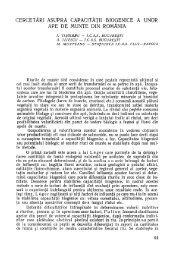
![studiu privind conditiilb] de vegetatie ale ... - EdituraSilvica.ro](https://img.yumpu.com/50877313/1/175x260/studiu-privind-conditiilb-de-vegetatie-ale-editurasilvicaro.jpg?quality=85)
